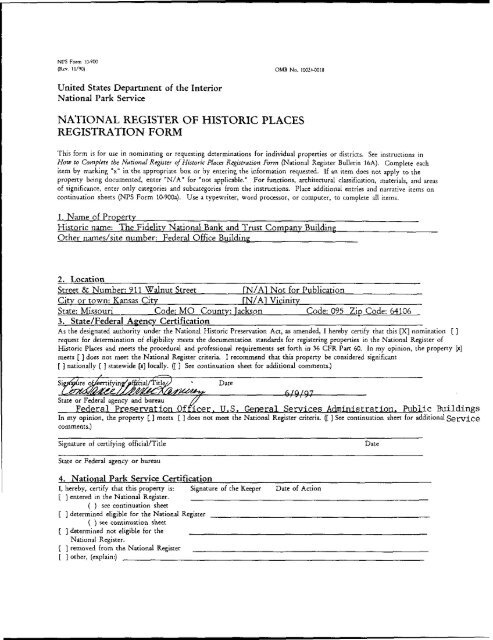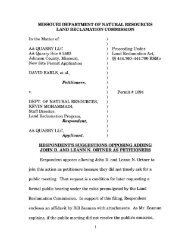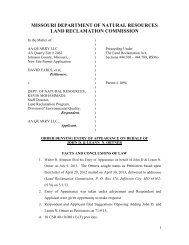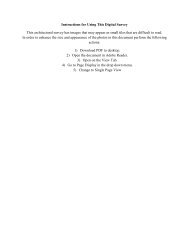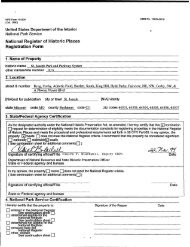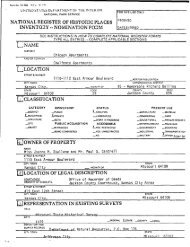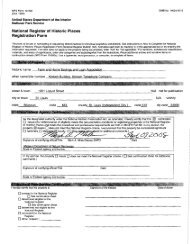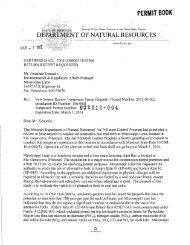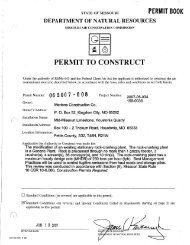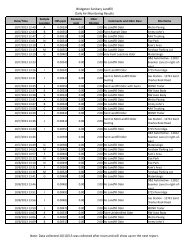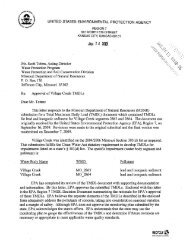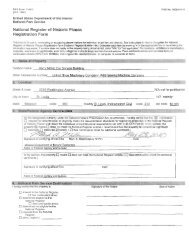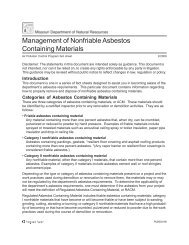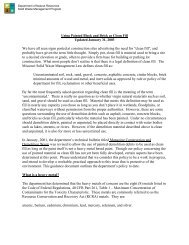Fidelity National Bank and Trust Co. Building - Missouri Department ...
Fidelity National Bank and Trust Co. Building - Missouri Department ...
Fidelity National Bank and Trust Co. Building - Missouri Department ...
You also want an ePaper? Increase the reach of your titles
YUMPU automatically turns print PDFs into web optimized ePapers that Google loves.
NPS Form 10-900<br />
(R"». >1"0)<br />
0MB No. 1M24JM1!<br />
United States <strong>Department</strong> of the Interior<br />
<strong>National</strong> Park Service<br />
NATIONAL REGISTER OF HISTORIC PLACES<br />
REGISTRATION FORM<br />
for individual properties or districts. See instructions ir<br />
1. Name of Property<br />
Historic name: The <strong>Fidelity</strong> <strong>National</strong> <strong>Bank</strong> <strong>and</strong> <strong>Trust</strong> <strong>Co</strong>mpany <strong>Building</strong><br />
Other names/site number: Federal Office Buildine______________<br />
2. Location______________________________________<br />
Street & Number: 911 Walnut Street_______FN/A1 Not for Publication<br />
City or town: Kansas City_____________FN/A1 Vicinity_______<br />
State: <strong>Missouri</strong>______<strong>Co</strong>de: MO <strong>Co</strong>unty: Tackson_______<strong>Co</strong>de: 095 Zip <strong>Co</strong>de: 64106<br />
3. State/Federal Agency Certification<br />
[ ] nationally [ ] statewide [x] locally. ([ ] See conti<br />
6/9/97<br />
fa/<br />
Federal Preservation Officer,. U.S. General Services Administration. Public <strong>Building</strong>s<br />
State or Federal agency <strong>and</strong> bureau<br />
In my opinion, the property £] meets [ ] does not meet the <strong>National</strong> Register criteria. ([ ] See continuation sheet for additional Service<br />
comments.)<br />
Signature of certifying official/Title<br />
Date<br />
State or Federal agency or bureau<br />
4. <strong>National</strong> Park Service Certification ___________________________________<br />
I, hereby, certify that this property is: Signature of the Keeper Date of Action<br />
[ ] entered in the <strong>National</strong> Register. ___________________________________________________<br />
( ) see continuation sheet<br />
[ ] determined eligible for the <strong>National</strong> Register _______________________________________________<br />
( ) see continuation sheet<br />
[ ] determined not eligible for the<br />
<strong>National</strong> Register.<br />
[ ] removed from the <strong>National</strong> Register __________________________________________________<br />
[ ] other, (explain:)
The <strong>Fidelity</strong> <strong>National</strong> <strong>Bank</strong> <strong>and</strong> <strong>Trust</strong> <strong>Co</strong>mpany <strong>Building</strong><br />
Name of Property<br />
Kansas City, MO<br />
<strong>Co</strong>unty <strong>and</strong> State<br />
5. Classification<br />
Ownership of Property Category of Property No. Resources within Property<br />
[ ] Private<br />
[X] <strong>Building</strong>(s)<br />
<strong>Co</strong>ntributing Noncontributing<br />
[ ] Public-Local<br />
[ ] District<br />
1 0 <strong>Building</strong>s<br />
[ ] Public-State<br />
[] Site<br />
0 0 Sites<br />
[X] Public-Federal<br />
[ ] Structure<br />
0 0 Structure<br />
[] Object<br />
0 0 Objects<br />
1 0 Total<br />
Name of related multiple property listing Number of contributing<br />
N/A<br />
Resources previously<br />
listed in the <strong>National</strong><br />
Register 0_____<br />
6. Function or Use<br />
Historic Functions (enter categories<br />
from instructions)<br />
COMMERCE/Financial Institution<br />
Current Functions (enter<br />
categories from instructions)<br />
GOVERNMENT/Government Office<br />
7. Description<br />
Architectural Classification<br />
(enter categories from instructions)<br />
Materials (enter categories<br />
from instructions)<br />
MODERN MOVEMENT/Art Deco<br />
foundation: <strong>Co</strong>ncrete___<br />
walls: Limestone<br />
Brick<br />
roof: Synthetic:<br />
other: <strong>Co</strong>pper<br />
Narrative Description<br />
Describe the historic <strong>and</strong> current condition of the property on one or more continuation sheets<br />
[X] See continuation sheet
NFS Form 10-9001<br />
11/90 OMB Approval No. 1024-0018<br />
United States <strong>Department</strong> of the Interior<br />
<strong>National</strong> Park Service<br />
NATIONAL REGISTER OF HISTORIC PLACES<br />
CONTINUATION SHEET<br />
<strong>Fidelity</strong> <strong>National</strong> <strong>Bank</strong> <strong>and</strong> <strong>Trust</strong> <strong>Co</strong>mpany <strong>Building</strong>, 911 Walnut Street, Kansas City, MO<br />
Section number 7 Page 1<br />
SUMMARY<br />
The <strong>Fidelity</strong> <strong>National</strong> <strong>Bank</strong> <strong>and</strong> <strong>Trust</strong> <strong>Co</strong>mpany <strong>Building</strong>, 911 Walnut Street, Kansas City,<br />
<strong>Missouri</strong>, is located at the southeast corner of 9th <strong>and</strong> Walnut streets. The massive building<br />
occupies approximately one quarter of the block bounded by 9th <strong>and</strong> 10th, Walnut <strong>and</strong> Gr<strong>and</strong><br />
streets. The thirty-five-story building is Art Deco in style, characterized by geometric forms,<br />
overall symmetry, vertical emphasis in building elements, <strong>and</strong> stylized ornament. The building's<br />
height is emphasized by a series of step backs, <strong>and</strong> stylized decorative detailing. The design <strong>and</strong><br />
massing of the <strong>Fidelity</strong> <strong>National</strong> <strong>Bank</strong> <strong>and</strong> <strong>Trust</strong> <strong>Co</strong>mpany <strong>Building</strong> exhibits a transition between<br />
the conservative Neo-Classical style <strong>and</strong> the more modern aesthetic as expressed by Art Deco; the<br />
traditional design of the base is sympathetic with its function as the bank's quarters, while the<br />
tower, a vertical shaft with stylized ornament, is articulated as a modern skyscraper office building.<br />
Similarly, the significant interior spaces are, like the base of the building, traditional in design <strong>and</strong><br />
proportion but ornamented with stylized decorative elements reflecting the Art Deco influences.<br />
The four-story base of the building, traditional in design, provides a heavy pedestal. The giant,<br />
fluted pilasters <strong>and</strong> end pavilions ground the composition. The tower soars gracefully above this<br />
base; its verticality is emphasized through a series of step backs <strong>and</strong> the regular fenestration. Pairs<br />
of sash windows create tall, brick piers, which are capped with bursts of ornament. The expression<br />
of the building's perpendicularity culminates in the twin towers that crown the composition.<br />
Displaying distinctive construction techniques <strong>and</strong> decorative motifs that were characteristic of the<br />
1920s <strong>and</strong> 1930s, the <strong>Fidelity</strong> <strong>National</strong> <strong>Bank</strong> <strong>and</strong> <strong>Trust</strong> <strong>Co</strong>mpany <strong>Building</strong> is in good structural<br />
condition <strong>and</strong> remains essentially intact, with some alterations to the interior.<br />
EXTERIOR<br />
MATERIALS AND GENERAL CONFIGURATION<br />
The site slopes up from west to east along 9th Street. The steel frame rests on solid rock 26' below<br />
the street. The structural frame consists of steel-reinforced concrete in a flat slab system. The flat<br />
slabs rest directly on the columns at each story. The building comprises thirty-four full stories with<br />
a sub-basement, a basement, <strong>and</strong> two towers <strong>and</strong> rises 465' 4" from the sidewalk. The maximum<br />
dimension of the footprint is 169.5' running north to south along Walnut Street <strong>and</strong> 110.5' running<br />
east to west along 9th Street. Rectangular in plan, the building st<strong>and</strong>s on the same site that the<br />
earlier <strong>Fidelity</strong> <strong>Bank</strong> <strong>Building</strong> (previously a U.S. Post Office) had stood since 1885.
NFS Form 10-900a<br />
11/90 OMB Approval No. 1024-0018<br />
United States <strong>Department</strong> of the Interior<br />
<strong>National</strong> Park Service<br />
NATIONAL REGISTER OF HISTORIC PLACES<br />
CONTINUATION SHEET<br />
<strong>Fidelity</strong> <strong>National</strong> <strong>Bank</strong> <strong>and</strong> <strong>Trust</strong> <strong>Co</strong>mpany <strong>Building</strong>, 911 Walnut Street, Kansas City, MO<br />
Section number 7 Page 2<br />
The massing of the <strong>Fidelity</strong> <strong>National</strong> <strong>Bank</strong> <strong>and</strong> <strong>Trust</strong> <strong>Co</strong>mpany <strong>Building</strong> is formed by a series of<br />
set backs, required by the City Planning <strong>Co</strong>mmission's 1923 zoning ordinance. Each street<br />
elevation is composed of a four-story, smooth, limestone base, above which is a series of three buffcolored<br />
brick <strong>and</strong> terra cotta set backs. These set backs are clearly marked with bursts of ornament<br />
that thrust toward the towers.<br />
The base of the building is expressed in the Neo-Classical style, consistent with its function as a<br />
public banking facility <strong>and</strong> private bank offices. A concrete foundation clad in polished grey-pink<br />
granite veneer rises approximately 6' above the sidewalk, leading to four stories clad in Indiana<br />
limestone. The four story base is marked with regular fenestration of the upper three stories. The<br />
interior bays, articulated with metal windows, are separated by fluted pilasters that rise three<br />
stories. The outer bays are surrounded by smooth, ashlar limestone, creating heavier end pavilions.<br />
Stylized, classically derived motifs have been carved, ornamenting the window sp<strong>and</strong>rels <strong>and</strong><br />
entryways. The frieze below the entablature is marked with medallions.<br />
The upper stories of the office shaft are covered with buff-colored brick. The exterior of the<br />
building is expressed through a series of set backs, one above the base of the building <strong>and</strong> two<br />
within the office tower, at the 26th <strong>and</strong> 31st stories. The upper stories are articulated with paired<br />
1/1, double-hung, sash metal windows. This arrangement of fenestration produces a vertical effect,<br />
creating piers that appear to rise from set back to set back. Terra cotta ornament is used to further<br />
enhance this effect. Stylized orders, floral antefix, <strong>and</strong> free st<strong>and</strong>ing details decorate the bases <strong>and</strong><br />
tops of the tall, brick piers, adding to the linear nature of these strips of wall.<br />
Two towers crown the composition. Square in plan, with chamfered corners, the north tower<br />
housed three clocks designed for the building. The south tower housed the original town clock<br />
saved from the previous building, allowing <strong>Fidelity</strong> <strong>National</strong> <strong>Bank</strong> <strong>and</strong> <strong>Trust</strong> <strong>Co</strong>mpany to keep its<br />
slogan, "Under the Old Town Clock." These brick <strong>and</strong> terra cotta towers are articulated in a<br />
manner similar to the stories below. Sheets of copper cladding cover the tower roofs.
NFS Form 10-900a<br />
11/90 OMB Approval No. 1024-0018<br />
United States <strong>Department</strong> of the Interior<br />
<strong>National</strong> Park Service<br />
NATIONAL REGISTER OF HISTORIC PLACES<br />
CONTINUATION SHEET<br />
<strong>Fidelity</strong> <strong>National</strong> <strong>Bank</strong> <strong>and</strong> <strong>Trust</strong> <strong>Co</strong>mpany <strong>Building</strong>, 911 Walnut Street, Kansas City, MO<br />
Section number _7__ Page 3<br />
WEST (MAIN FACADE), NORTH, AND EAST ELEVATIONS<br />
The main elevation of the <strong>Fidelity</strong> <strong>National</strong> <strong>Bank</strong> <strong>and</strong> <strong>Trust</strong> <strong>Co</strong>mpany <strong>Building</strong> is oriented to the<br />
west, fronting on Walnut Street. This elevation is nine bays wide at the four-story base, eight bays<br />
wide from the fifth through the twenty-fifth story, <strong>and</strong> seven bays wide to the towers. The<br />
distinguishing features include three central entrances with ornate carved door surrounds, fluted<br />
pilasters that separate the central bays, stylized classical ornamentation at the base of the building,<br />
<strong>and</strong> Deco-style linear ornament at the office tower.<br />
The lower four stories are nine bays wide <strong>and</strong> Neo-Classical in style with Art Deco overtones.<br />
This portion of the building has been constructed following a classically derived formula: the first<br />
story is articulated as a raised basement, appropriate to its sloping site; the second <strong>and</strong> third<br />
(mezzanine) stories have been united with ornamental metal sp<strong>and</strong>rels <strong>and</strong> window frames joining<br />
the metal windows at these levels <strong>and</strong> creating a piano nobile; the fourth story is marked with<br />
smaller paired sash windows, resulting in an attic level that is capped with a wide frieze <strong>and</strong><br />
entablature. Stylized, classically derived ornamentation decorates this portion of the building.<br />
The building is anchored by a tall polished granite base that rises approximately 6' above the<br />
sidewalk. Two courses of rusticated ashlar Indiana limestone rise above the granite, leading to a<br />
molded water table. At the base of the building, three ornately carved surrounds mark the<br />
openings in the center three bays. Granite base blocks support the b<strong>and</strong>ed architrave <strong>and</strong> panel of<br />
each door surround, which is carved with medallions, aegncanes, festoons of fruit, bell flowers, <strong>and</strong><br />
foliage. Floral metal cresting with anthemia crowns each doorway. At the center of the cresting<br />
over the central door is an octagonal stone clock. All three doorways originally housed glass <strong>and</strong><br />
metal revolving doors. Now, the outer two doorways are infilled with granite panels, <strong>and</strong> the<br />
center opening has been altered to hold a pair of modern bronzed anodized aluminum <strong>and</strong> glass<br />
doors beneath granite panels. On either side of these openings are two bays of store front<br />
windows. A keystone marks the center of each bay. The storefront windows have been altered<br />
over time. Currently each opening contains a single fixed sash window. A fourth entrance is<br />
located in the southernmost bay of the first story. This entrance leads through a recessed vestibule<br />
to three pairs of metal <strong>and</strong> glass commercial doors to the elevator lobby of the building. Three<br />
openings are surrounded with painted metal fluted pilasters <strong>and</strong> floral motifs that decorate this<br />
tripartite entranceway. Above this metal work, modern metal letters reading, "Federal Office<br />
<strong>Building</strong>," have been mounted. At either side of the doorway are surface-mounted metal letters<br />
reading, "911" <strong>and</strong> a medallion ornamented with an eagle. The northernmost bay is marked at the<br />
first story with two modern fixed sash windows <strong>and</strong> a painted metal security door opening.
NTS Form 10-900i<br />
11/90 OMB Approval No. 1024-0018<br />
United States <strong>Department</strong> of the Interior<br />
<strong>National</strong> Park Service<br />
NATIONAL REGISTER OF HISTORIC PLACES<br />
CONTINUATION SHEET<br />
<strong>Fidelity</strong> <strong>National</strong> <strong>Bank</strong> <strong>and</strong> <strong>Trust</strong> <strong>Co</strong>mpany <strong>Building</strong>, 911 Walnut Street, Kansas City, MO<br />
Section number 7 Page 4<br />
The second <strong>and</strong> third stories are divided into nine bays, which are marked by metal windows.<br />
These windows have a tripartite configuration that accentuates the verticality of the building's<br />
composition. Ornamental metal sp<strong>and</strong>rels <strong>and</strong> window frames are used to join the windows of the<br />
central seven bays. Above these seven windows are carved limestone sp<strong>and</strong>rels decorated with<br />
satyrs <strong>and</strong> cornucopia. The fourth story is marked with seven pairs of 1/1, double-hung, sash<br />
windows with carved mullions. The second, third, <strong>and</strong> fourth stories are united through the use of<br />
seven giant, fluted pilasters with foliate capitals. The outer bays of the facade are differentiated<br />
through the use of smooth, ashlar limestone, creating solid end pavilions. These outer bays are<br />
marked with metal windows with transoms <strong>and</strong> carved stone surrounds at the second <strong>and</strong> third<br />
stones <strong>and</strong> with single sash windows with simple carved stone surrounds at the fourth story. The<br />
entire composition is crowned with an ashlar limestone frieze with a laurel wreath at the center <strong>and</strong><br />
a carved title reading, "FIDELITY NATIONAL BANK AND TRUST COMPANY." In smaller<br />
letters beneath this title the words, "FOUNDED A.D. 1899" <strong>and</strong> "ERECTED A.D. 1931," have<br />
been carved. Flanking the inscription are pairs of bas-relief medallions displaying the bank's<br />
corporate seal.<br />
The materials <strong>and</strong> details on the lower stories of the north elevation match those on the west<br />
elevation with only a few exceptions. The north elevation is only five bays wide, <strong>and</strong> due to the<br />
slope of the street, the lower portion of the first story, or raised basement, is obscured by the rising<br />
grade. Likewise, the granite base disappears from view near the center of the elevation. A single<br />
entrance is located on the north elevation. A simplified version of the ornate door surround on the<br />
facade ornaments this secondary entrance. The opening is filled with a bronze <strong>and</strong> glass door with<br />
sidelights. The remainder of this elevation of the base is detailed like the facade with the exception<br />
of the frieze, which is marked only with three medallions.<br />
The east elevation addresses a shared service alley. Like the facade, the base of this elevation is nine<br />
bays wide. However, unlike the facade, because of the change in grade, this elevation appears only<br />
three stones tall. Due to its lack of exposure to the public, the base at this elevation is clad almost<br />
completely with buff-colored brick laid in stretcher bond. The one portion that can be seen from<br />
the street, the northernmost bay, is clad in limestone. The molded watertable <strong>and</strong> window frames<br />
match those on the north elevation, but the original windows have been removed. In their place, a<br />
metal exterior mounted HVAC duct has been introduced.<br />
The openings at the "second" story in this elevation are filled with stacked sash, metal windows.<br />
At the third <strong>and</strong> fourth stories, the openings are filled with sash, metal windows in paired openings.<br />
All openings are simply detailed with flat stone sills <strong>and</strong> steel sills capped with rowlock. At the
NFS Form 10-900a<br />
11/90 OMB Approval No. 1024-0018<br />
United States <strong>Department</strong> of the Interior<br />
<strong>National</strong> Park Service<br />
NATIONAL REGISTER OF HISTORIC PLACES<br />
CONTINUATION SHEET<br />
<strong>Fidelity</strong> <strong>National</strong> <strong>Bank</strong> <strong>and</strong> <strong>Trust</strong> <strong>Co</strong>mpany <strong>Building</strong>, 911 Walnut Street, Kansas City, MO<br />
Section number 7<br />
Page _5_<br />
south end of the elevation is a door opening with a painted metal security door. The base of this<br />
elevation is capped by simple limestone coping.<br />
The tall brick- <strong>and</strong> terra cotta-clad shaft of offices is set back from the base beneath on the east,<br />
west, <strong>and</strong> north elevations. Above the fourth story, eighty feet above the sidewalk, the tower steps<br />
back approximately 20 feet at each of these elevations. All three elevations are similar in<br />
appearance, excepting the metal fire escape that is mounted on the east elevation. Due to the set<br />
backs, the elevations are reduced to eight bays on the east <strong>and</strong> west elevations, <strong>and</strong> three bays on<br />
the north elevation at the first set back. The bays are demarcated by wide brick piers that extend<br />
from the fifth story through the twenty-fifth story. Within these bays are paired 1/1, sash, metal<br />
windows, which are separated in turn by brick mullions. The fifth, sixth, <strong>and</strong> seventh stories are<br />
clad in buff-colored brick. Above the seventh story, a frieze of molded terra cotta extends across<br />
each elevation. Above the windows, the terra cotta tiles are fluted, but at the brick piers, a floral<br />
motif is introduced. Fluted terra cotta ornaments the brick piers as they rise from this b<strong>and</strong> to the<br />
eleventh story, terminating in floral bursts of ornament. Beneath the windows at the eleventh<br />
story are fluted terra cotta sp<strong>and</strong>rels decorated with terra cotta medallions. The brick-clad<br />
elevations extend unadorned to the twenty-fifth story, interrupted only by a series of terra cotta<br />
floral sp<strong>and</strong>rels beneath the windows of the twenty-second story. It is at this point that the corners<br />
of the building are chamfered. The use of plain brick is resumed until the twenty-fifth story, where<br />
fluted terra cotta sp<strong>and</strong>rels are located beneath the windows <strong>and</strong> floral sp<strong>and</strong>rels above them. Terra<br />
cotta coping marks the edge of the set back. The top of each wide brick pier is crowned with a<br />
vigilant eagle, poised for flight. Terminating each elevation of this set back, large acroteria face out<br />
from the corners at a 45 degree angle.<br />
The west, north, <strong>and</strong> east elevations each step back again at the twenty-sixth story by<br />
approximately four feet. The west <strong>and</strong> east elevations remain eight bays wide, <strong>and</strong> the north<br />
elevation remains four bays wide. However, to account for the set back, the outer bays are reduced<br />
to a single sash window instead of a pair. The four corners of the building are fully chamfered.<br />
The five-story block is ornamented with fluted terra cotta pilasters like those that rise from the<br />
seventh story. Floral ornament caps the windows of this set back, <strong>and</strong> terra cotta coping crowns<br />
the block, as at the twenty-fifth story.<br />
At the twenty-sixth story, the west, north, <strong>and</strong> east elevations step back once again, creating a<br />
"dumbbell" shaped plan that is carried through the thirty-fourth story. All three elevations at this<br />
height are ornately decorated with terra cotta sp<strong>and</strong>rels, urns, <strong>and</strong> acroterium. From the ends of<br />
the dumbbell rise two square towers with chamfered corners. These towers are crowned with<br />
hipped copper roofs. The four elevations of the south tower contain paired windows. The north
NFS Form 10-900a<br />
11/90 OMB Approval No. 1024-0018<br />
United States <strong>Department</strong> of the Interior<br />
<strong>National</strong> Park Service<br />
NATIONAL REGISTER OF HISTORIC PLACES<br />
CONTINUATION SHEET<br />
<strong>Fidelity</strong> <strong>National</strong> <strong>Bank</strong> <strong>and</strong> <strong>Trust</strong> <strong>Co</strong>mpany <strong>Building</strong>, 911 Walnut Street, Kansas City, MO<br />
Section number 7 Page 6<br />
tower is marked with openings in the east, west, <strong>and</strong> north sides. Three openings in the north<br />
tower <strong>and</strong> one in the south tower originally contained clock faces, but these have since been infilled<br />
with metal siding.<br />
SOUTH ELEVATION<br />
The first three stories of the south elevation of the limestone base of the building are obscured by a<br />
building that abuts the <strong>Fidelity</strong> <strong>National</strong> <strong>Bank</strong> <strong>and</strong> <strong>Trust</strong> <strong>Co</strong>mpany <strong>Building</strong>. The limestone veneer<br />
of the facade wraps around the westernmost twenty feet of the exposed fourth story. The rest of<br />
the elevation is clad in the same buff colored brick employed in the office tower. Original window<br />
openings in the exposed fourth story have been infilled with brick. Limestone coping marks the<br />
top of the four-story base of the building.<br />
The fifth through the thirtieth story of the south elevation are clad entirely in brick. The office<br />
tower at this elevation is four bays wide. The outer bays of each story are marked with single 2/2,<br />
sash, metal windows. At each story, metal louver vents mark the inner bays. Owing to the set<br />
back above the twenty-fifth story, the uppermost window opening marks the twenty-fifth story.<br />
The vents, however, continue to the thirtieth story.<br />
The placement of the openings on the south elevation further underscores the vertical nature of the<br />
tower. This verticality is further reinforced by four vertical b<strong>and</strong>s of tan-colored brick that extend<br />
from the fifth to the thirtieth story. These vertical stripes are broken at levels that correspond to<br />
the set backs on the other elevations. Decorative sp<strong>and</strong>rels <strong>and</strong> fluted piers, like those on the other<br />
elevations, are introduced at the twenty-fifth story <strong>and</strong> extend to the base of the south tower.<br />
INTERIOR<br />
The interior of the <strong>Fidelity</strong> <strong>National</strong> <strong>Bank</strong> <strong>and</strong> <strong>Trust</strong> <strong>Co</strong>mpany <strong>Building</strong> is supported by steel<br />
square columns, or piers, which follow the bay system established on the exterior of the building.<br />
In some of the more public spaces, these columns are free-st<strong>and</strong>ing <strong>and</strong> sheathed in marble, but in<br />
the more private office space, the columns are incorporated into the partitions <strong>and</strong> are covered in<br />
plaster. The public spaces <strong>and</strong> executive offices are richly detailed with ornament that is modern in<br />
interpretation - revealing the building's link to Art Deco. The private areas, such as the tower of<br />
offices, are more simply detailed, with plastered hollow tile partitions separating tenant spaces.
NFS Form 10-900a<br />
11/90 OMB Approval No. 1024-0018<br />
United States <strong>Department</strong> of the Interior<br />
<strong>National</strong> Park Service<br />
NATIONAL REGISTER OF HISTORIC PLACES<br />
CONTINUATION SHEET<br />
<strong>Fidelity</strong> <strong>National</strong> <strong>Bank</strong> <strong>and</strong> <strong>Trust</strong> <strong>Co</strong>mpany <strong>Building</strong>, 911 Walnut Street, Kansas City, MO<br />
Section number 7 Page 7<br />
Originally, the four-story base of the building was devoted to banking services <strong>and</strong> retail. The safe<br />
deposit was located in the basement of the building. The first floor was to serve as retail space <strong>and</strong><br />
to provide a gr<strong>and</strong> entrance to the main banking hall on the second floor. The third floor, or<br />
mezzanine, was occupied by offices for the bank executives <strong>and</strong> an ornate Director's Room. The<br />
fourth floor was devoted to more mundane banking services like bookkeeping <strong>and</strong> transit<br />
departments. The significant spaces of the building are located in this four-story base <strong>and</strong> include<br />
the main lobby, the banking spaces, the vault, <strong>and</strong> the Director's Room. All spaces are highly<br />
designed using the classical orders <strong>and</strong> rich materials like marble, American black walnut, <strong>and</strong><br />
ornamental plaster.<br />
Vertical circulation is provided by two banks of elevators, three in each, located on the south side<br />
of the building. Additionally, one stair is housed in the southeast corner of the building <strong>and</strong> one at<br />
the center of the northern edge of the base. The elevators are decorated with molded cast metal<br />
doors at the lobby level.<br />
The tower of offices above is utilitarian in presentation, <strong>and</strong> therefore simpler in design. The upper<br />
floors were conceived as open space that could be adapted for a variety of functions through the<br />
installation of hollow tile partitions. The sub-basement, which occupies the southernmost 48 feet<br />
of the building <strong>and</strong> runs from the east to the west wall, contains various service areas <strong>and</strong><br />
machinery. The towers that crown the composition, which originally housed the town clock <strong>and</strong><br />
three additional clocks, provide space for elevator machinery.<br />
LOBBIES AND BANKING HALL<br />
Original Description<br />
The main lobby of the building was originally accessed through three doors located at the center of<br />
the Walnut Street elevation. The floor of the lobby was covered in marble laid in geometric<br />
patterns. The walls were designed using classical motifs, with a system of light colored marble<br />
pilasters rising above a wide marble base. The cornice of the lobby was decorated with ornamental<br />
plaster with wavescroll <strong>and</strong> chevron detailing. Off the lobby were five store rooms for tenants. At<br />
the rear of the lobby a marble stair, 14'-6" wide with a central rail supported by ornamental brass<br />
legs, led to the main banking floor. Cast metal grills ornamented with chevrons <strong>and</strong> foliage flanked<br />
the stair at the l<strong>and</strong>ing. Pendant lights with ornate metal cresting hung from the lobby ceiling.
NFS Form 10-900a<br />
11/90 OMB Approval No. 1024-0018<br />
United States <strong>Department</strong> of the Interior<br />
<strong>National</strong> Park Service<br />
NATIONAL REGISTER OF HISTORIC PLACES<br />
CONTINUATION SHEET<br />
<strong>Fidelity</strong> <strong>National</strong> <strong>Bank</strong> <strong>and</strong> <strong>Trust</strong> <strong>Co</strong>mpany <strong>Building</strong>, 911 Walnut Street, Kansas City, MO<br />
Section number 7<br />
Page Jj<br />
The main banking space, 34'-8" by 87'-6", was located on the second floor of the building. The<br />
marble stair, marked by a marble balustrade, rose to the center of this floor. The design of this<br />
room was based on Beaux-Arts principles. Free st<strong>and</strong>ing piers, three by three <strong>and</strong> one-half feet,<br />
followed the rhythm established on the exterior of the building. These piers rose to support a<br />
double height ceiling, 38 feet above the floor, <strong>and</strong> were articulated as pilasters. Behind the eastern<br />
row of columns was an arcade 7'-9" wide <strong>and</strong> ornamented with classically inspired detailing.<br />
Behind the arcade was a bank of tellers' desks richly detailed with marble. A loggia, the corridor of<br />
the third or mezzanine floor, looked out over the banking hall.<br />
The floor of the banking hall was laid in geometric patterns of triangular slabs of Tennessee marble<br />
in three shades. A Greek key border of Tennessee marble surrounded this field, <strong>and</strong> a marble edge<br />
of Belgium Black lined the floor. The pilaster bases were of black <strong>and</strong> gold <strong>and</strong> Florido creme<br />
marbles. The faces of the pilasters that address the lobby rose the full two stories in height <strong>and</strong><br />
were clad with fluted Botticino marble that rose to <strong>Co</strong>rinthian capitals. The sides of these piers<br />
extend only one story, as they support the mezzanine level loggia. These interior pilasters of<br />
Florido creme are capped with Ionic capitals. An entablature above these one-story columns<br />
encircled the lobby, weaving behind the two-story columns. This entablature was ornamented with<br />
cast plaster medallions <strong>and</strong> a cornice of dentils. Foliate carved panels lined the third floor loggia,<br />
<strong>and</strong> intermediate pilasters of ornamental plaster <strong>and</strong> stone defined the openings. An entablature of<br />
dentils capped the entire composition <strong>and</strong> led to an ornate plaster frieze based on floral motifs.<br />
Above was a cornice of dentils <strong>and</strong> plaster ceiling with ornate designs of foliage, scrolls, <strong>and</strong><br />
classical motifs. Both the frieze <strong>and</strong> the ceiling were decorated with colors derived from the<br />
marbles below: greys <strong>and</strong> corals with accents of blue, green, <strong>and</strong> gold. Three large ch<strong>and</strong>eliers of<br />
bronze <strong>and</strong> molded glass illuminated the gr<strong>and</strong> space. Six large, bronze check desks ornamented<br />
with chased <strong>and</strong> etched bronze lined the room.<br />
Current Description<br />
This area has been adapted as office space for the federal government. A floor has been inserted<br />
across the original double height banking space, <strong>and</strong> the original stair between the first <strong>and</strong> second<br />
floor has been removed. The walls have been covered with dry wall. The ceilings have been<br />
dropped with acoustical tile, likely obscuring much of the original ornament. Fluorescent lighting<br />
has been installed.
NFS Form 10-900a<br />
11/90 OMB Approval No. 1024-0018<br />
United States <strong>Department</strong> of the Interior<br />
<strong>National</strong> Park Service<br />
NATIONAL REGISTER OF HISTORIC PLACES<br />
CONTINUATION SHEET<br />
<strong>Fidelity</strong> <strong>National</strong> <strong>Bank</strong> <strong>and</strong> <strong>Trust</strong> <strong>Co</strong>mpany <strong>Building</strong>, 911 Walnut Street, Kansas City, MO<br />
Section number 7 Page 9<br />
SOUTH ELEVATOR LOBBY<br />
The elevator lobby, rectangular in plan, is located at the southern end of the building. The lobby<br />
is entered from Walnut Street through a modern, bronze anodized aluminum <strong>and</strong> glass airlock<br />
vestibule. The corridor is irregular in plan, extending along the south exterior wall, with a leg to<br />
the north to accommodate two banks of three elevators. The corridor is ornamented with marble<br />
floors, marble walls, <strong>and</strong> a decorative plaster ceiling.<br />
The floor of the elevator lobby is covered with pink-with-grey-vemed marble laid in a diaper<br />
pattern with b<strong>and</strong>ing. Black marble borders surround the composition, <strong>and</strong> the walls are lined with<br />
a 16" base of the same black marble. The fields of the walls are clad with cream-colored travertine.<br />
The wall surface is interrupted with large decorative brass radiator grills ornamented with floral<br />
Deco-style designs, modern bronze directories, <strong>and</strong> the elevator banks. The elevator doors are of<br />
brushed aluminum <strong>and</strong> are set within molded jambs <strong>and</strong> beveled lintels. Above each elevator is an<br />
aluminum <strong>and</strong> glass indicator light. A plaster frieze ornamented with anthemion <strong>and</strong> capped with a<br />
dentil molding encircles the lobby. The plaster ceiling is relieved with a series of slightly recessed<br />
vaults with cross beams that continue the dentil moldings. These vaults are detailed with multi<br />
colored borders <strong>and</strong> recessed central panels with Deco-style floral <strong>and</strong> geometric shape designs, but<br />
the only bay to retain the original color system is the westernmost bay. Troughs allowing modern<br />
indirect lighting have been suspended from the ceiling.<br />
A flight of stairs is located at the east end of the lobby. The marble treads are placed on metal<br />
risers, <strong>and</strong> a decorative cast-iron <strong>and</strong> wood railing lines the stair.<br />
At the second floor, the elevator lobby originally led to the banking space. The stairwell <strong>and</strong><br />
corridor are finished like the floor below. The elevator banks are as below, but carved bas-relief<br />
marble panels ornamented with floral scrolls <strong>and</strong> b<strong>and</strong>s are located above the elevator door<br />
openings. The original marble wall surface of the elevator lobby is capped by a gilded plaster b<strong>and</strong><br />
of Deco-style, Egyptian-derived ornament. Above the b<strong>and</strong> are alternating panels of fluting <strong>and</strong><br />
gilded floral scrolls like those above the elevator doors. The original ornate coffered ceiling of the<br />
double-height elevator lobby features gilded borders <strong>and</strong> flat, recessed panels. Two modern pendant<br />
fluorescent lights hang from the ceiling. The original entrance to the banking space, formerly filled<br />
with an ornate metal gate, has been much altered. The decorative metal lintel bearing the firm's<br />
insignia remains intact, but the other metalwork has been removed <strong>and</strong> replaced with glazing <strong>and</strong><br />
double-leaf doors.
NFS Form 10-900a<br />
11/90 OMB Approval No. 1024-0018<br />
United States <strong>Department</strong> of the Interior<br />
<strong>National</strong> Park Service<br />
NATIONAL REGISTER OF HISTORIC PLACES<br />
CONTINUATION SHEET<br />
<strong>Fidelity</strong> <strong>National</strong> <strong>Bank</strong> <strong>and</strong> <strong>Trust</strong> <strong>Co</strong>mpany <strong>Building</strong>, 911 Walnut Street, Kansas City, MO<br />
Section number 7 Page 10<br />
The cast-iron <strong>and</strong> marble stairway in the east corner of the building continues to the third <strong>and</strong><br />
fourth floors of the building. The motifs established on the first <strong>and</strong> second floor corridors are<br />
continued on the third <strong>and</strong> fourth floors, but the design of these spaces is simpler than those below.<br />
The pink marble introduced below is again used as wainscoting. This pink marble is also used as<br />
flat jambs <strong>and</strong> lintels at the elevator <strong>and</strong> north end wall. The fields of the wall are flat painted<br />
plaster capped with a plain cornice. The ceilings are flat painted plaster.<br />
The third floor circulation is differentiated from the other banking floors by the introduction of a<br />
corridor that runs north-south along the eastern side of the plan. This corridor, which leads to the<br />
Director's Room, originally looked out over the highly-ornamented banking hall, but has since<br />
been enclosed. Pairs of pilasters <strong>and</strong> molded plaster cross beams form a rhythmic march along the<br />
corridor walls. The floor is covered in beige terrazzo squares lined with gray borders <strong>and</strong> cross<br />
b<strong>and</strong>s. A black granite base <strong>and</strong> marble wainscoting line the hall. Along the east wall are three<br />
recessed doorways that lead to the Director's Room. These stepped recesses feature ornamental<br />
plaster <strong>and</strong> molded marble door surrounds. Recessed panels trimmed with dentils crown the<br />
doorways. The crown molding is decorated with b<strong>and</strong>s of foliate scrolls. The ceiling consists of a<br />
series of recessed panels defined by the decorative cross beams. The stepped ceiling panels contain<br />
ornate plaster air grilles with floral medallions <strong>and</strong> rosette designs. Pendant fluorescent lights have<br />
been mounted over the plaster grilles.<br />
DIRECTOR'S ROOM AND EXECUTIVE OFFICES<br />
The Director's Room, 22' by 54', is located at the east side of the building. The room is currently<br />
carpeted. The walls are clad with floor-to-ceiling wood panelling, <strong>and</strong> highly ornamented painted<br />
plaster covers the ceiling.<br />
A pair of panelled wood doors is centered on the western wall of the room. To either side of the<br />
entrance are built in closets. Grouped in evenly spaced pairs on the east wall are six large, 2/2 sash<br />
windows with single light transoms. The north wall contains a single wood door at the west end<br />
of the wall <strong>and</strong> three openings to allow for movie projection. The south end of the room features<br />
a small raised platform <strong>and</strong> a central single door that leads to an adjacent room.<br />
The floor was originally covered in carpeting of black background with figured patterns in greys,<br />
grey-greens, <strong>and</strong> rose. A black marble base skirts the room. The walls are divided into bays by<br />
fluted wood pilasters. The door surrounds are intricately carved with floral designs, <strong>and</strong> the main
NPS Form 10-900a<br />
11/90 OMB Approval No. 1024-0018<br />
United States <strong>Department</strong> of the Interior<br />
<strong>National</strong> Park Service<br />
NATIONAL REGISTER OF HISTORIC PLACES<br />
CONTINUATION SHEET<br />
<strong>Fidelity</strong> <strong>National</strong> <strong>Bank</strong> <strong>and</strong> <strong>Trust</strong> <strong>Co</strong>mpany <strong>Building</strong>, 911 Walnut Street, Kansas City, MO<br />
Section number 7 Page 11<br />
entrance to the room is crowned with a shield. The fields of the walls are covered figured panelling<br />
of American black walnut enriched by carved molding <strong>and</strong> panels of inlaid wood. At the cornice a<br />
b<strong>and</strong> of reeding encircles the room. Window valances with inserts of tooled leather of brown, red,<br />
<strong>and</strong> gold cap the windows.<br />
The ceiling of the room is covered with intricate plaster work, featuring scrolls <strong>and</strong> foliate designs.<br />
Floral details were incorporated into a medallion motif, allowing speakers <strong>and</strong> brass air grilles to be<br />
incorporated into the design at the centers of the medallions. This plaster ceiling was painted in<br />
black, red <strong>and</strong> gold. Pendant bronze <strong>and</strong> glass lights were suspended from the ceiling.<br />
The executive offices, also located on the third floor, were, like the Director's Room, highly<br />
ornamented. These rooms had walnut wainscots, textured walls, <strong>and</strong> decorated plastered ceilings.<br />
Although the original carpeting has been replaced <strong>and</strong> fluorescent lighting has been installed, the<br />
Director's Room remains very much intact today. The other executive offices, however, have been<br />
refinished as typical office space with linoleum, drywall, <strong>and</strong> dropped ceilings.<br />
VAULT ANTEROOM<br />
The vault is located at the basement level of the building. Rectangular in plan, this room features<br />
terrazzo floors, plaster walls with a simple cornice, a vaulted ceiling with decorative plasterwork,<br />
<strong>and</strong> decorative metal grillwork. The original security vault door remains in place on the north wall<br />
of the anteroom.<br />
The floor is covered with beige <strong>and</strong> grey terrazzo laid in a stylized sunburst, reflecting the ceiling<br />
plan of the basement. The walls are flat painted plaster capped with a simple cornice. The painted<br />
plaster ceiling is vaulted with two octagonal recessed panels divided by a molded plaster cross beam.<br />
Reeding <strong>and</strong> floral details typical of the Art Deco style ornament the vaulted ceiling. Fluorescent<br />
lights <strong>and</strong> sprinkler equipment have been suspended from this ceiling.<br />
OFFICE TOWER CORRIDOR<br />
The elevator lobbies are located at the south end of each floor. These lobbies feature terrazzo<br />
floors, plaster walls, <strong>and</strong> marble wainscot panels. The plaster ceilings were originally ornamented<br />
with cross beams <strong>and</strong> simple cornices.
NPS Form 10-900a<br />
11/90 OMB Approval No. 1024-0018<br />
United States <strong>Department</strong> of the Interior<br />
<strong>National</strong> Park Service<br />
NATIONAL REGISTER OF HISTORIC PLACES<br />
CONTINUATION SHEET<br />
<strong>Fidelity</strong> <strong>National</strong> <strong>Bank</strong> <strong>and</strong> <strong>Trust</strong> <strong>Co</strong>mpany <strong>Building</strong>, 911 Walnut Street, Kansas City, MO<br />
Section number 7__ Page 12<br />
The floors of the elevator lobbies are fields of pink <strong>and</strong> grey terrazzo squares edged in dark grey<br />
terrazzo. Marble wainscoting extend approximately 3 feet above the floor <strong>and</strong> skirts the lobbies.<br />
Elevator doors are flush. These elevator lobbies open to double-loaded corridors. The terrazzo<br />
floors <strong>and</strong> marble wainscoting continues into the corridors. The walls of the corridors are pierced<br />
with glazed wood stile <strong>and</strong> rail doors.<br />
Some of the lobbies <strong>and</strong> corridors have been altered through the installation of carpeting, dropped<br />
acoustical tile ceilings, <strong>and</strong> fluorescent lights. In many instances, the double-loaded corridor has<br />
been removed to create open plan offices.<br />
TENANT OFFICES<br />
Hollow tile partitions divide the offices in the tower. Most of the floors in the offices have been<br />
covered with linoleum or carpeting. The interior walls have been plastered or covered with<br />
drywall <strong>and</strong> painted. The ceilings are generally dropped acoustical tile, obscuring the installation of<br />
electrical, HVAC, fire sprinkler, <strong>and</strong> communication systems. Some original metal <strong>and</strong> glass<br />
partition walls remain in place, <strong>and</strong> a few original wood doors, baseboards, chair rails, picture rails,<br />
<strong>and</strong> window casings remain.<br />
ALTERATIONS<br />
The major interior alteration of the building is the use of the double-height banking hall as two<br />
floors of offices. Some of the original marble <strong>and</strong> plasterwork, although damaged, may be intact<br />
beneath the drywall <strong>and</strong> dropped ceilings.
The <strong>Fidelity</strong> <strong>National</strong> <strong>Bank</strong> <strong>and</strong> <strong>Trust</strong> <strong>Co</strong>mpany Buildine<br />
Name of Property<br />
Kansas City. MO<br />
<strong>Co</strong>unty <strong>and</strong> State<br />
8. Statement of Significance<br />
Applicable <strong>National</strong> Register Criteria<br />
(Mark x in one or more boxes for the criteria qualifying the property for <strong>National</strong> Register listing.)<br />
[ X ] A Property is associated with events that have made a significant contribution to the broad<br />
patterns of our history.<br />
[ ] B Property is associated with the lives of persons significant in our past.<br />
[ X ] C Property embodies the distinctive characteristics of a type, period, or method of<br />
construction or represents the work of a master, or possesses high artistic values, or represents a<br />
significant <strong>and</strong> distinguishable entity whose components lack individual distinction.<br />
[ ] D Property has yielded, or is likely to yield, information important in prehistory or history.<br />
Criteria <strong>Co</strong>nsiderations<br />
{Mark x in al! the boxes that apply.)<br />
Property is:<br />
[ ] A owned by a religious institution or used for religious purposes.<br />
[ ] B removed from its original location.<br />
[ ] C a birthplace or grave.<br />
[ ] D a cemetery.<br />
[ ] E a reconstructed building, object, or structure.<br />
[ ] F a commemorative property.<br />
[ ] G less than 50 years of age or achieved significance within the past 50 years.<br />
Areas of Significance Period of Significance Significant Dates<br />
(enter categories from instructions)<br />
Architecture_______ 1930-1932________ 1930-1932______<br />
<strong>Co</strong>mmerce<br />
1932-1933<br />
1932-1933<br />
Significant Person<br />
N/A_________<br />
Cultural Affiliation<br />
N/A__________<br />
Architect/Builder<br />
Hoit, Price & Barnes. Architects<br />
State significance of property, <strong>and</strong> justify criteria, criteria considerations, <strong>and</strong> areas <strong>and</strong> period of significance noted above.<br />
[X] See continuation sheet
NFS Form 10-900a<br />
11/90 OMB Approval No. 1024-0018<br />
United States <strong>Department</strong> of the Interior<br />
<strong>National</strong> Park Service<br />
NATIONAL REGISTER OF HISTORIC PLACES<br />
CONTINUATION SHEET<br />
<strong>Fidelity</strong> <strong>National</strong> <strong>Bank</strong> <strong>and</strong> <strong>Trust</strong> <strong>Co</strong>mpany <strong>Building</strong>, 911 Walnut Street, Kansas City, MO<br />
Section number _8_<br />
Page _1_<br />
STATEMENT OF SIGNIFICANCE<br />
SUMMARY<br />
The construction of <strong>Fidelity</strong> <strong>National</strong> <strong>Bank</strong> <strong>and</strong> <strong>Trust</strong> <strong>Co</strong>mpany flagship at 9th <strong>and</strong> Walnut streets<br />
not only anchored <strong>and</strong> celebrated Kansas City's business community, but the building <strong>and</strong> its<br />
institution led the way in the development of city's financial district around the Federal Reserve<br />
<strong>Bank</strong>, as occurred in the other Federal Reserve cities across the country.<br />
The imposing structure <strong>and</strong> architecture of the <strong>Fidelity</strong> <strong>National</strong> <strong>Bank</strong> <strong>and</strong> <strong>Trust</strong> <strong>Co</strong>mpany<br />
<strong>Building</strong> in Kansas City attest to the establishment's significance <strong>and</strong> symbolize the importance <strong>and</strong><br />
success of Kansas City as a banking center in the first decades of the twentieth century.<br />
<strong>Co</strong>nstructed between 1930 <strong>and</strong> 1932, during Kansas City's hey day as a prosperous banking <strong>and</strong><br />
financial nucleus for the Mid-Western states, the building forms the centerpiece for the city's<br />
financial district. Kansas City's banking industry was not only locally important, but gained<br />
national attention when, in 1914, one of the twelve <strong>National</strong> Federal Reserve banks was located<br />
there serving Wyoming, <strong>Co</strong>lorado, <strong>Missouri</strong>, Nebraska <strong>and</strong> portions of <strong>Missouri</strong>, Oklahoma, <strong>and</strong><br />
New Mexico. The building affirms the importance of <strong>Fidelity</strong> <strong>National</strong> <strong>Bank</strong> <strong>and</strong> <strong>Trust</strong> <strong>Co</strong>mpany,<br />
one of the largest 100 banks in the nation in the early 1930s. Thus, although liquidated the year<br />
after construction, the bank held a prominent role, not only in Kansas City but nationwide in 1932<br />
<strong>and</strong> 1933.<br />
The <strong>Fidelity</strong> <strong>National</strong> <strong>Bank</strong> <strong>and</strong> <strong>Trust</strong> <strong>Co</strong>mpany <strong>Building</strong> has also achieved significance as the<br />
embodiment of a distinctive style, expressed by its ornamentation, form, <strong>and</strong> method of<br />
construction. The <strong>Fidelity</strong> <strong>National</strong> <strong>Bank</strong> <strong>and</strong> <strong>Trust</strong> <strong>Co</strong>mpany <strong>Building</strong> (1930-1932) is designed in<br />
the Art Deco style, a modern aesthetic ideally translated to the architecture of skyscrapers<br />
constructed in the 1920s <strong>and</strong> 1930s. This building style broke with the classical <strong>and</strong> revivalist<br />
traditions so popular in the early twentieth century, <strong>and</strong> created architecture of soaring forms <strong>and</strong><br />
geometric motifs. Spurred by the 1925 Exposition Internationale des Arts Decoratifs et Industries<br />
Modernes, Art Deco strove for modernity <strong>and</strong> a new expression for the machine age. Looking to<br />
the future, the style is characterized by linear edges, angular compositions with vertical emphasis,<br />
<strong>and</strong> stylized ornament. <strong>Building</strong>s in this style frequently feature set backs that emphasize the<br />
geometric form of the building.<br />
Although the base of the <strong>Fidelity</strong> <strong>National</strong> <strong>Bank</strong> <strong>and</strong> <strong>Trust</strong> <strong>Co</strong>mpany <strong>Building</strong> employed a<br />
traditional design scheme, a modern interpretation, evident in the stylized low relief ornament, was<br />
applied even to this more conventional portion of the building. The office tower itself was<br />
thoroughly modern, expressing the Zeitgeist with its verticality, set backs, geometric form, <strong>and</strong>
NFS Form 10-900a<br />
11/90 OMB Approval No. 1024-0018<br />
United States <strong>Department</strong> of the Interior<br />
<strong>National</strong> Park Service<br />
NATIONAL REGISTER OF HISTORIC PLACES<br />
CONTINUATION SHEET<br />
<strong>Fidelity</strong> <strong>National</strong> <strong>Bank</strong> <strong>and</strong> <strong>Trust</strong> <strong>Co</strong>mpany <strong>Building</strong>, 911 Walnut Street, Kansas City, MO<br />
Section number 8 Page 2<br />
stylized decorative details. Further, the <strong>Fidelity</strong> <strong>National</strong> <strong>Bank</strong> <strong>and</strong> <strong>Trust</strong> <strong>Co</strong>mpany is an<br />
outst<strong>and</strong>ing example of the work of prominent Kansas City architects, Hoit, Price, <strong>and</strong> Barnes.<br />
The excellence of the building's design was acclaimed by the Kansas City chapter of the American<br />
Institute of Architects, which voted it the best designed commercial building of 1931.<br />
HISTORICAL SIGNIFICANCE OF THE FIDELITY NATIONAL BANK AND TRUST<br />
COMPANY BUILDING IN THE BANKING INDUSTRY<br />
The <strong>Fidelity</strong> <strong>Trust</strong> <strong>Co</strong>mpany was chartered on June 24, 1899, <strong>and</strong> the first office was opened in<br />
Kansas City in the New York Life <strong>Building</strong> (NHRP 1887-1890) on July 10, 1899. The first<br />
president of the bank, Mr. Henry C. Flower, headed a distinguished list of subscribers. This<br />
"Who's Who" of banking included: James Stillman, president of the <strong>National</strong> City <strong>Bank</strong> of New<br />
York; Philip D. Armour, PA. Valentine, <strong>and</strong> K.B. Armour of Armour & <strong>Co</strong>., packers, Chicago;<br />
William W. Crapo of New Bedford, Massachusetts, financier, president of the Pere Marquette<br />
Railway, former congressman <strong>and</strong> chairman of the banking committee; Charles S. Fairchild,<br />
president of the New York <strong>Trust</strong> <strong>Co</strong>. <strong>and</strong> former Secretary of the treasury under President Grover<br />
Clevel<strong>and</strong>; George J. Gould, son of J. Gould, a national force in the financial world; John A.<br />
McCall, president of the New York Life Insurance <strong>Co</strong>; <strong>and</strong> Marshall Field of Chicago. From this<br />
auspicious beginning, the bank grew <strong>and</strong>, in 1902, acquired the Kansas City Post Office Federal<br />
<strong>Co</strong>urts <strong>Building</strong> (1879-1885) at the corner of 9th Street <strong>and</strong> Walnut Street as its new home. Its new<br />
building, a two-towered Romanesque Revival-style building housed the town clock, leading the<br />
bank to its slogan, "Under the Old Town Clock."<br />
<strong>Fidelity</strong> moved into its new quarters in 1904, <strong>and</strong> continued to grow at an exponential rate. This<br />
rapid growth forced the bank to construct an addition at the south of the building in 1913. Just<br />
four years later, it became necessary for the bank to add on to its building at the north elevation.<br />
Even with these additions, the bank rapidly outgrew its new quarters.<br />
<strong>Bank</strong>ing, already a thriving business, began to boom in Kansas City with the introduction of a<br />
regional Federal Reserve bank in 1914. In 1913, President Woodrow Wilson signed the Federal<br />
Reserve Act, creating a central banking system with regional Federal Reserve banks. These banks<br />
would in turn serve member commercial banks. Twelve Federal Reserve banks were established to<br />
provide banking services such as holding cash reserves, lending to banks, collecting <strong>and</strong> clearing<br />
checks, transferring funds, providing currency, <strong>and</strong> serving as the government's fiscal agency to<br />
member banks. The Federal Reserve in Kansas City, <strong>Missouri</strong>, was the banking center for District<br />
No. 10, which included Wyoming, <strong>Co</strong>lorado, Kansas, Nebraska, <strong>and</strong> portions of <strong>Missouri</strong>,
NFS Form 10-9001<br />
11/90 OMB Approval No. 1024-0018<br />
United States <strong>Department</strong> of the Interior<br />
<strong>National</strong> Park Service<br />
NATIONAL REGISTER OF HISTORIC PLACES<br />
CONTINUATION SHEET<br />
<strong>Fidelity</strong> <strong>National</strong> <strong>Bank</strong> <strong>and</strong> <strong>Trust</strong> <strong>Co</strong>mpany <strong>Building</strong>, 911 Walnut Street, Kansas City, MO<br />
Section number 8 Page 3<br />
Oklahoma, <strong>and</strong> New Mexico. This district was second in area only to the twelfth district, which<br />
included all the western states. The number of member banks District 10 claimed was 835, second<br />
only to the seventh district (Chicago). When the Federal Reserve bank was created, it served a<br />
population of 6,306,850. It was acknowledged that the location of these banks "may have a<br />
considerable influence on commerce <strong>and</strong> industry in various localities."'<br />
Prior to World War I, European banks dominated the global financial market; however, with the<br />
advent of World War I, Europe's attention was completely diverted. This boosted American trade<br />
with other countries, <strong>and</strong> the export of the dollar increased, leading to unprecedented growth<br />
among U.S. banks.<br />
<strong>Fidelity</strong>, like many other commercial banks, continued to exp<strong>and</strong> through a succession of mergers.<br />
In 1919 the <strong>National</strong> City <strong>Bank</strong> of Kansas City was merged with <strong>Fidelity</strong> <strong>Trust</strong> <strong>Co</strong>mpany,<br />
producing the <strong>Fidelity</strong> <strong>National</strong> <strong>Bank</strong> <strong>and</strong> <strong>Trust</strong> <strong>Co</strong>mpany. Other banks later absorbed by <strong>Fidelity</strong><br />
included the New Engl<strong>and</strong> <strong>National</strong> <strong>Bank</strong> <strong>and</strong> <strong>Trust</strong> <strong>Co</strong>mpany (1929), the Western Exchange <strong>Bank</strong><br />
(1930), <strong>and</strong> the Liberty <strong>National</strong> <strong>Bank</strong> (1930). <strong>Bank</strong> employees were scattered throughout the<br />
financial district with a large personnel office at 10th <strong>and</strong> Gr<strong>and</strong>, 10th <strong>and</strong> Baltimore, <strong>and</strong> the<br />
<strong>Fidelity</strong> Savings <strong>Trust</strong> <strong>Co</strong>mpany at 1000 Gr<strong>and</strong> Street. In 1929, a total of 41 national <strong>and</strong> state<br />
banks <strong>and</strong> trust companies <strong>and</strong> 63 building <strong>and</strong> loan associations were located in Greater Kansas<br />
City2 , <strong>and</strong> by 1930, a solid financial district bounded by Gr<strong>and</strong>, 9th, Baltimore, <strong>and</strong> 10th Streets,<br />
had been established. Within these boundaries were the Atlantis Acceptance <strong>Co</strong>rporation (1012<br />
Baltimore), First <strong>National</strong> <strong>Bank</strong> (10th <strong>and</strong> Baltimore), Baltimore <strong>Bank</strong> (1022 Baltimore), <strong>Fidelity</strong><br />
Savings <strong>Trust</strong> <strong>Co</strong>mpany (1000 Gr<strong>and</strong>), Pioneer <strong>Trust</strong> <strong>Co</strong>mpany (1014-1016 Baltimore), <strong>and</strong> <strong>Fidelity</strong><br />
<strong>National</strong> <strong>Bank</strong> (9th <strong>and</strong> Walnut). Within a block of this area were four additional banks: the<br />
Federal Reserve (on Gr<strong>and</strong> near 10th), Sterling State <strong>Bank</strong> (1125 McGee), Traders Gate City<br />
<strong>National</strong> <strong>Bank</strong> (1111 Gr<strong>and</strong>), <strong>and</strong> Home <strong>Trust</strong> <strong>Co</strong>mpany (111-1119 Walnut).<br />
It eventually became evident that the bank would need to construct a new building to house its<br />
employees. It was decided that this new bank should feature an office tower, which would<br />
eventually profit the bank. During this period, headquarter offices of banks were constructed on<br />
prominent sites on corners <strong>and</strong> main streets. True to this idea, the new building was to be<br />
constructed on the site of the old building, at the crest of a hill at the southeast corner of 9th <strong>and</strong><br />
1 "The New <strong>Bank</strong>ing System." <strong>Bank</strong>ers Magazine. February 1914. p. 141.<br />
2 Roy L:!lis .-/ Civic History of Kansas City. <strong>Missouri</strong>. Springfield. <strong>Missouri</strong>: Elkins-Swycrs <strong>Co</strong>.. 1930.
IMPS Form 10-900a<br />
11/90 OMB Approval No. 1024-0018<br />
United States <strong>Department</strong> of the Interior<br />
<strong>National</strong> Park Service<br />
NATIONAL REGISTER OF HISTORIC PLACES<br />
CONTINUATION SHEET<br />
<strong>Fidelity</strong> <strong>National</strong> <strong>Bank</strong> <strong>and</strong> <strong>Trust</strong> <strong>Co</strong>mpany <strong>Building</strong>, 911 Walnut Street, Kansas City, MO<br />
Section number 8 Page 4<br />
Walnut streets. These new bank buildings often functioned as city l<strong>and</strong>marks, as the new <strong>Fidelity</strong><br />
<strong>National</strong> <strong>Bank</strong> <strong>and</strong> <strong>Trust</strong> <strong>Building</strong> would do for Kansas City.<br />
During the 1920s <strong>and</strong> even into the 1930s, commercial banks were constructed on a scale <strong>and</strong> level<br />
of gr<strong>and</strong>eur not seen previously. No expense was spared for these new, monumental buildings<br />
constructed for major commercial banks. <strong>Fidelity</strong> <strong>National</strong> <strong>Bank</strong> was no different. The bank was<br />
ranked the 100th largest bank in the nation in 1931, while its new quarters were being constructed. 3<br />
As the foremost bank in Kansas City, the bank wanted to erect a city l<strong>and</strong>mark. Hoit, Price, <strong>and</strong><br />
Barnes were selected as the architects for this project. The guidelines established for the project<br />
were limited to two criteria: (1) the banking quarters had to be classical in design, like a traditional<br />
bank; <strong>and</strong> (2) the bank, like the earlier incarnation, was to have two towers, one of which was to<br />
house the old town clock. 4<br />
Although construction in Kansas City peaked in 1925, building continued on a gr<strong>and</strong> scale. Even<br />
the stock market crash did not devastate the construction industry. Between the building periods<br />
of 1923-1926 <strong>and</strong> 1927-1930, the number of buildings erected declined by 61 percent. In contrast,<br />
the cost of the buildings built only declined by 16 percent. Kansas City's growth was inspired <strong>and</strong><br />
sustained by the developing farming, aircraft, <strong>and</strong> automobile industries, <strong>and</strong> by the tireless efforts<br />
of Tom Pendergast, a Jackson <strong>Co</strong>unty political figure who propelled the construction industry<br />
through the Depression.<br />
Although Pendergast was able to temporarily stem the tide of the Depression, hard times eventually<br />
fell on Kansas City. One year after the bank opened, <strong>Fidelity</strong> <strong>National</strong> <strong>Bank</strong> <strong>and</strong> <strong>Trust</strong> <strong>Co</strong>mpany,<br />
like many banks across the country during the Depression, failed <strong>and</strong> was liquidated. Although<br />
<strong>Fidelity</strong> <strong>National</strong> <strong>Bank</strong> <strong>and</strong> <strong>Trust</strong> <strong>Co</strong>mpany occupied this building for less than a year, the banking<br />
floors did continue to serve as bank facilities from 1935 until the federal government moved in the<br />
early 1950s.<br />
Since that time, the federal government has continued to occupy the <strong>Fidelity</strong> <strong>National</strong> <strong>Bank</strong> <strong>and</strong><br />
<strong>Trust</strong> <strong>Co</strong>mpany <strong>Building</strong>, changing its name to the Kansas City Federal Office <strong>Building</strong> on July 1,<br />
1951.<br />
' "The Nation's 100 Largest <strong>Bank</strong>s." The <strong>Bank</strong>ers Monthly. August. 1931, p. 474.<br />
4 Telephone interview with Kansas City Architect <strong>and</strong> Local Historian Richard Farnan. September II, 1996. Mr. Faman<br />
had previously interviewed a staff member of Hoit. Price, <strong>and</strong> Barnes. who was involved in the project. Robert Blumgarten.
NFS Form 10-900a<br />
11/90 OMB Approval No. 1024-0018<br />
United States <strong>Department</strong> of the Interior<br />
<strong>National</strong> Park Service<br />
NATIONAL REGISTER OF HISTORIC PLACES<br />
CONTINUATION SHEET<br />
<strong>Fidelity</strong> <strong>National</strong> <strong>Bank</strong> <strong>and</strong> <strong>Trust</strong> <strong>Co</strong>mpany <strong>Building</strong>, 911 Walnut Street, Kansas City, MO<br />
Section number 8 Page 5<br />
SUMMARY OF HISTORICAL SIGNIFICANCE<br />
With the introduction of the Federal Reserve system, Kansas City gained national importance in<br />
1914 as a regional headquarters for the Federal Reserve. Under the jurisdiction of Kansas City,<br />
District Ten was the second largest <strong>and</strong> second most populous district in the country. Thus,<br />
banking in Kansas City, already flourishing, began to boom. In the early 1930s, Kansas City, a<br />
national banking capital, claimed three of the nation's 100 largest banks, one of which was <strong>Fidelity</strong><br />
<strong>National</strong> <strong>Bank</strong> <strong>and</strong> <strong>Trust</strong> <strong>Co</strong>mpany. With its employees dispersed throughout a number of<br />
buildings in Kansas City, <strong>Fidelity</strong> <strong>National</strong> <strong>Bank</strong> <strong>and</strong> <strong>Trust</strong> <strong>Co</strong>mpany decided to unite under one<br />
roof, building a monument to their prestigious organization.<br />
In gr<strong>and</strong>eur, scale, <strong>and</strong> iconography, the 1931 <strong>Fidelity</strong> <strong>National</strong> <strong>Bank</strong> <strong>and</strong> <strong>Trust</strong> <strong>Co</strong>mpany <strong>Building</strong><br />
proclaimed the bank's importance as a major commercial venture in a Federal Reserve city. Its<br />
form <strong>and</strong> iconography alluded to its operations as a financial establishment, from the classicallyinspired<br />
base of the building to the eagles perched on the upper set backs who guard the building,<br />
<strong>and</strong> the money within. The rich materials - marbles, bronze, <strong>and</strong> walnut - convey the wealth of<br />
the bank. The building's soaring towers <strong>and</strong> height, (465'-4"), its imposing ornament <strong>and</strong><br />
innovative design, <strong>and</strong> its housing of the town clock in its tower, create an impressive city<br />
l<strong>and</strong>mark, anchoring one end of Kansas City's skyline.<br />
THE ARCHITECTURAL SIGNIFICANCE OF THE FIDELITY NATIONAL BANK AND<br />
TRUST COMPANY BUILDING<br />
The <strong>Fidelity</strong> <strong>National</strong> <strong>Bank</strong> <strong>and</strong> <strong>Trust</strong> <strong>Co</strong>mpany <strong>Building</strong> is eligible for listing in the <strong>National</strong><br />
Register under criterion "C", as a significant example of Art Deco architecture in Kansas City <strong>and</strong><br />
as an important work of the prominent Kansas City firm, Hoit, Price, <strong>and</strong> Barnes. The building<br />
displays the streamlined forms of Art Deco design, symbolizing modernity <strong>and</strong> a new era of<br />
progress. The building combined traditional classical motifs, iconographic elements, <strong>and</strong> more<br />
mystical elements derived from ancient cultures like the Mayans <strong>and</strong> Egyptians. Highly stylized<br />
variations of these motifs ornamented the building inside <strong>and</strong> out. Typical of the Art Deco style,<br />
the geometric form of the building, emphasized by the building's set backs, <strong>and</strong> the building's<br />
vertically were underscored at night by the use of hidden floodlights that illuminated the office<br />
tower. This building, which was for approximately six months the tallest building in the city,<br />
anchored one end of the skyline, becoming a symbol for the city itself. According to Architectural<br />
Historian George Ehrlich, the <strong>Fidelity</strong> <strong>National</strong> <strong>Bank</strong> <strong>and</strong> <strong>Trust</strong> <strong>Co</strong>mpany <strong>Building</strong> is a
NPS Form 10-900a<br />
11/90 OMB Approval No. 1024-0018<br />
United States <strong>Department</strong> of the Interior<br />
<strong>National</strong> Park Service<br />
NATIONAL REGISTER OF HISTORIC PLACES<br />
CONTINUATION SHEET<br />
<strong>Fidelity</strong> <strong>National</strong> <strong>Bank</strong> <strong>and</strong> <strong>Trust</strong> <strong>Co</strong>mpany <strong>Building</strong>, 911 Walnut Street, Kansas City, MO<br />
Section number 8 Page 6<br />
representative statement in office building design of the period ... <strong>and</strong> mark[s] the importance of<br />
Hoit, Price & Barnes as architects of the period between the World Wars." 5<br />
The architecture of the first two decades of the twentieth century were largely characterized by<br />
revivalist traditions. The popularity of the Beaux-Arts, Neo-Classical, <strong>and</strong> <strong>Co</strong>lonial Revival styles<br />
attest to this trend. Art Deco was spurred primarily by two events, the 1925 Paris Exposition<br />
Internationale des Arts Decoratifs <strong>and</strong> Industriels Modernes, which featured works of "new inspiration<br />
<strong>and</strong> real originality"6, <strong>and</strong> by the 1922 Chicago Tribune Tower competition. The Paris exposition<br />
strictly prohibited historical styles, promoting a sentiment for modernity <strong>and</strong> the idea that<br />
ornament could be used to achieve this goal. Louis Sullivan's widely publicized praise for Eliel<br />
Saannen's Chicago Tribune Tower entry established unrelieved verticality as the model for tall<br />
buildings. Henry Russell Hitchcock pronounced the entry's freedom from Gothic ornament <strong>and</strong><br />
use of stylized ornament as nearly original. This praise resulted in the advocacy of design that was<br />
independent of historical precedent.<br />
Art Deco-style architecture was characterized by the composition of geometric forms with a vertical<br />
emphasis. <strong>Building</strong>s were often arranged as a series of step backs, emphasizing this linear, hard edge<br />
composition. Ornament was highly stylized <strong>and</strong> ranged from floral <strong>and</strong> foliate motifs to geometric<br />
forms, particularly chevrons <strong>and</strong> fluting, <strong>and</strong> included decoration derived from ancient sources,<br />
including the Egyptian <strong>and</strong> Mayan cultures. To this modern generation, the streamlined forms of<br />
the Art Deco style symbolized a new era <strong>and</strong> progress. In Kansas City, the Art Deco style was<br />
applied to a number of building types including office buildings, apartment buildings, banks, hotels,<br />
department stores, <strong>and</strong> other commercial buildings.<br />
During the 1920s <strong>and</strong> early 1930s, Kansas City was experiencing a period of prosperity, <strong>and</strong><br />
construction was booming. During the 1910s a few tall buildings had been built, but it was in the<br />
1920s <strong>and</strong> 1930s that Kansas City developed status as a city with a highrise skyline. This<br />
development was spurred in part by the city's growing prominence in the national arena. The city<br />
served as a refueling stop for flights between Los Angeles <strong>and</strong> the East <strong>Co</strong>ast. Air cabins during<br />
this period were not pressurized, <strong>and</strong> many passengers deplaned at the city. Thus, the city became<br />
a stopover for many of the more prominent figures from these cities. During these decades, most<br />
s George Ehrlich. Kansas City, <strong>Missouri</strong>: An Architectural History. <strong>Co</strong>lumbia, MO: University of <strong>Missouri</strong> Press,<br />
1992. pp. 96-97.<br />
h John Poppeliers. S. Alien Chambers, <strong>and</strong> Nancy B. Schwartz. What Style Is It? Washington, DC: The Preservation<br />
Press, n.d- p. 39,
NFS Form 10-900a<br />
11/90 OMB Approval No. 1024-0018<br />
United States <strong>Department</strong> of the Interior<br />
<strong>National</strong> Park Service<br />
NATIONAL REGISTER OF HISTORIC PLACES<br />
CONTINUATION SHEET<br />
<strong>Fidelity</strong> <strong>National</strong> <strong>Bank</strong> <strong>and</strong> <strong>Trust</strong> <strong>Co</strong>mpany <strong>Building</strong>, 911 Walnut Street, Kansas City, MO<br />
Section number _8_ Page 7<br />
of the nation still travelled by train, but Kansas City's role as a layover between the coasts assured<br />
that many of the stars, the executives, <strong>and</strong> the adventurous saw this city in the midwest.<br />
"Everybody knew Kansas City was a great modern city because everybody could see those An<br />
Deco downtown towers when flying into the main airport." 7<br />
Kansas City's use of the Art Deco style was also influenced by the zoning ordinance developed in<br />
the 1920s. The City Planning <strong>Co</strong>mmission was organized in 1920, <strong>and</strong> one year later the State<br />
Zoning Enabling Act was passed. A draft of a zoning plan was drawn up by the <strong>Co</strong>mmission in<br />
1922, <strong>and</strong> in 1923 the final version was passed. This resulted in the city's control of l<strong>and</strong> use,<br />
building height, <strong>and</strong> area of lot. The plan, modelled on New York's 1916 zoning legislation,<br />
required set backs on the city's tall buildings. The first project to be regulated by this new law was<br />
the 1929 addition to the 1919 Southwestern Bell Telephone building at 324 E. llth Street. The<br />
fourteen story addition, designed by Hoit, Price, <strong>and</strong> Barnes, employed step backs as required by<br />
the law.<br />
In 1930, the firm of Hoit, Price, <strong>and</strong> Barnes was chosen to design the <strong>Fidelity</strong> <strong>National</strong> <strong>Bank</strong> <strong>and</strong><br />
<strong>Trust</strong> <strong>Co</strong>mpany <strong>Building</strong>. This Kansas City firm was made up of three partners, Henry Ford Hoit,<br />
Edwin Morgan Price, <strong>and</strong> Alfred Edward Barnes. The firm was responsible for a number of<br />
projects throughout the city ranging from single family houses to large commercial structures. The<br />
firm was consistently ranked among the top three architectural firms in Kansas City from the 1910s<br />
until the firm was dissolved in the 1940s. Hoit, Price, <strong>and</strong> Barnes was responsible for the design of<br />
a number of notable buildings in Kansas City including the Kansas City Power & Light <strong>Co</strong>mpany<br />
<strong>Building</strong> (NRHP Determined Eligible, Ref. #88001852), the <strong>Co</strong>ntinental Hotel (NRHP Listed, Ref,<br />
#83000997), <strong>and</strong> the Southwestern Bell Telephone <strong>Co</strong>mpany <strong>Building</strong>. Other buildings by the firm<br />
included the Temple B'nai Jehudah, Longview Farm, Independence Boulevard Christian Church,<br />
<strong>and</strong> the Robert Keith Furniture <strong>Building</strong>.<br />
The oldest partner of the firm was Henry Ford Hoit (1872-1951). Henry Ford Hoit was born in<br />
Chicago on August 4, 1872. In 1892, Hoit graduated from Chicago's Manual Training School,<br />
where he showed an early talent for drawing <strong>and</strong> design. Inspired by the Beaux-Arts architecture at<br />
the 1893 <strong>Co</strong>lumbian Exposition in Chicago, he turned to study architecture, apprenticing himself to<br />
Dwight Perkins, a Chicago Prairie School Architect. At Perkins' suggestion, Hoit went on to<br />
attend the Massachusetts Institute of Technology, graduating in 1897. A member of Delta Kappa<br />
7 Barbara Baer Caprtman. Rediscovering An Deco. USA. Ne\v York. NY: Viking Studio Books. 1994.
NFS Form 10-900a<br />
11/90 OMB Approval No. 1024-0018<br />
United States <strong>Department</strong> of the Interior<br />
<strong>National</strong> Park Service<br />
NATIONAL REGISTER OF HISTORIC PLACES<br />
CONTINUATION SHEET<br />
<strong>Fidelity</strong> <strong>National</strong> <strong>Bank</strong> <strong>and</strong> <strong>Trust</strong> <strong>Co</strong>mpany <strong>Building</strong>, 911 Walnut Street, Kansas City, MO<br />
Section number 8 Page 8<br />
Epsilon, Hoit made the acquaintance of another fraternity member, William H. Cutler, a draftsman<br />
in the Kansas City office of the Boston firm, Van Brunt & Howe. Cutler wrote to Hoit:<br />
We are covered up with work here <strong>and</strong> now have the chance at another job that is<br />
too big to turn down; I speak of one of the main buildings to be put up for the<br />
World's Fair in St. Louis. We need a man who can take full charge of the men <strong>and</strong><br />
design on this job. Would you consider the job? 8<br />
Henry Hoit accepted this offer, going to Kansas City in 1901 to design the Varied Industry<br />
<strong>Building</strong> for the St. Louis World's Fair. Soon after Hoit's arrival, Van Brunt retired, <strong>and</strong> the office<br />
became known as Howe, Hoit <strong>and</strong> Cutler in 1904, Cutler retired three years later, leaving the firm<br />
as Howe <strong>and</strong> Hoit, where Hoit practiced until establishing his own firm in 1910, <strong>and</strong> joined his<br />
partners, Edwin Morgan Price, <strong>and</strong> Alfred Edward Barnes in 1919. Price was president of the<br />
Kansas City Chapter of the A.I.A. <strong>and</strong> served as a member of a number of chapter committees. In<br />
1938 Hoit was elected a Fellow of the A.I.A., an honor only previously bestowed on four Kansas<br />
City architects. Hoit later served as Director for the Central States Region of the A.I.A.<br />
Edwin Morgan Price (1884-1957), another partner in the firm was born in 1884 in Webb City,<br />
Arkansas. Shortly thereafter, Price's family moved to Fort Smith, Arkansas, where Price attended<br />
public school. Price's talent for drawing led him to an apprenticeship in the architecture office of<br />
H.I. Gottard in Fort Smith. In 1903, Price moved to St. Louis <strong>and</strong> worked for Legg & Holoway,<br />
Eames & Young, Weber & Groves, <strong>and</strong> the Louisiana Purchase Exposition. In 1905, Price went to<br />
Kansas City to work for the firm, Howe, Hoit <strong>and</strong> Cutler, where he first met Henry Ford Hoit.<br />
In 1907 Price attended a year-long architecture course at Hoit's alma mater, the Massachusetts<br />
Institute of Technology. Price remained in this architectural firm, becoming Hoit's partner in<br />
1913. In 1919, the firm became known as Hoit, Price, <strong>and</strong> Barnes.<br />
The third partner of Hoit, Price, <strong>and</strong> Barnes, Alfred Edward Barnes, was the only Kansas City<br />
native of the partnership. Alfred Edward Barnes was born in Kansas City on March 5, 1892.<br />
Although Barnes originally hoped to become a civil engineer, he instead found work at the<br />
architecture firm of Henry Hoit in 1909. Based on his talent for drafting, Barnes was shortly made<br />
chief draftsman <strong>and</strong> within ten years was made partner of the firm, Hoit, Price, <strong>and</strong> Barnes.<br />
* Henry F. Moil. "Turning Point in My Career." Kansas City Star, March 9, 1930.
NFS Form 10-900a<br />
11/90 OMB Approval No. 1024-0018<br />
United States <strong>Department</strong> of the Interior<br />
<strong>National</strong> Park Service<br />
NATIONAL REGISTER OF HISTORIC PLACES<br />
CONTINUATION SHEET<br />
<strong>Fidelity</strong> <strong>National</strong> <strong>Bank</strong> <strong>and</strong> <strong>Trust</strong> <strong>Co</strong>mpany <strong>Building</strong>, 911 Walnut Street, Kansas City, MO<br />
Section number _S_ Page _9_<br />
In 1930, Hoit, Price, <strong>and</strong> Barnes, already a prominent architecture firm within Kansas City, sealed<br />
their reputation by being awarded the two most prestigious commissions of the year: the new<br />
<strong>Fidelity</strong> <strong>National</strong> <strong>Bank</strong> <strong>and</strong> <strong>Trust</strong> <strong>Co</strong>mpany <strong>Building</strong> <strong>and</strong> the Kansas City Power <strong>and</strong> Light<br />
<strong>Building</strong>. When Hoit, Price, <strong>and</strong> Barnes received the commission for the new <strong>Fidelity</strong> <strong>National</strong><br />
<strong>Bank</strong> <strong>and</strong> <strong>Trust</strong> <strong>Co</strong>mpany <strong>Building</strong>, two restrictions were placed on the architects. The new<br />
building was to pay homage to the old building in that it must have two towers, one of which was<br />
to house the town clock. The new building was also to be classical in design, in other words to<br />
look like a bank. Two additional staff members of Hoit, Price, <strong>and</strong> Barnes, Robert Blumgarten <strong>and</strong><br />
Kent Frowerk, were charged with the ornamentation of the building. Significantly, Blumgarten,<br />
during a gr<strong>and</strong> tour of Europe had heard tell of the Paris Exposition. Ab<strong>and</strong>oning his travels in<br />
Switzerl<strong>and</strong> <strong>and</strong> Austria, Blumgarten went to see the exposition. Although at the time Blumgarten<br />
claimed to have been unimpressed by the exposition, in retrospect he acknowledged the great<br />
impact it had on his work.' Blumgarten had just returned from being loaned out to the<br />
architectural firm of Keene <strong>and</strong> Bradley for work on one of Tulsa's Art Deco buildings, the<br />
Philcade Tower <strong>and</strong> was promptly assigned to the new <strong>Fidelity</strong> building.<br />
The <strong>Fidelity</strong> <strong>National</strong> <strong>Bank</strong> <strong>and</strong> <strong>Trust</strong> <strong>Co</strong>mpany <strong>Building</strong>, while conforming to the bankers'<br />
traditional requirements, was a conscious <strong>and</strong> distinct expression of the modern style. The form, a<br />
tower based on geometric shapes <strong>and</strong> feature set backs is typical of the Art Deco style. The use of<br />
linear elements like brick piers <strong>and</strong> ornament to emphasize the vertically of the building is also<br />
characteristic of the style. The verticality of the brick piers is reinforced with the use of terra cotta<br />
sp<strong>and</strong>rels, fluted pilasters, <strong>and</strong> bursts of foliage that shoot up from these piers. At night the<br />
building's reach skyward was illuminated by floodlights set at each step back that shone upward<br />
along the tower. The vertical nature of the building culminates in the twin towers that crown the<br />
composition. The hard-edged low relief terra cotta ornament, like the ornate, foliate sp<strong>and</strong>rels <strong>and</strong><br />
fluted piers are typical of the style. Although the base, as required by the bankers, is classical in<br />
design, even this detailing, though rooted in tradition, is Art Deco in spirit: stylized, hard-edged,<br />
<strong>and</strong> more abstract. Stylized interpretations of traditional ornament, the fluted terra cotta pilasters<br />
that spring from the step backs, the vigilant eagles who sit atop the second step back, <strong>and</strong> the<br />
<strong>Fidelity</strong> shields that punctuate the entablature of the base, sign the function of the building.<br />
The interior of the building, like the exterior, featured Deco-style stylized ornament. Geometric<br />
forms decorate the floors. Notably in the vault, a highly stylized sunburst, a motif commonly<br />
u Telephone interview with Kansas City Architect <strong>and</strong> Local Historian Richard Faman. September II. 1996.
NFS Form 10-900a<br />
11/90 OMB Approval No. 1024-0018<br />
United States <strong>Department</strong> of the Interior<br />
<strong>National</strong> Park Service<br />
NATIONAL REGISTER OF HISTORIC PLACES<br />
CONTINUATION SHEET<br />
<strong>Fidelity</strong> <strong>National</strong> <strong>Bank</strong> <strong>and</strong> <strong>Trust</strong> <strong>Co</strong>mpany <strong>Building</strong>, 911 Walnut Street, Kansas City, MO<br />
Section number 8 Page 10<br />
associated with Art Deco, decorates the floor. Lavish plaster ceilings were painted in polychromy,<br />
another feature typical of the style.<br />
SUMMARY OF ARCHITECTURAL SIGNIFICANCE<br />
Several other Art Deco commercial buildings are contemporary with the <strong>Fidelity</strong> <strong>National</strong> <strong>Bank</strong><br />
<strong>and</strong> <strong>Trust</strong> <strong>Co</strong>mpany <strong>Building</strong> including Hoit, Price, <strong>and</strong> Barnes' Power <strong>and</strong> Light <strong>Building</strong>, the<br />
restrained Bryant <strong>Building</strong> (1102 Gr<strong>and</strong> Avenue), <strong>and</strong> the Professional <strong>Building</strong> (1103 Gr<strong>and</strong><br />
Avenue). The <strong>Fidelity</strong> <strong>National</strong> <strong>Bank</strong> <strong>Building</strong>, like the already listed Power <strong>and</strong> Light <strong>Building</strong>, is<br />
distinguished in its expression of the Art Deco movement through its composition, height, <strong>and</strong> use<br />
of ornamentation. The building expresses the Zeitgeist of the age with its verticality, set backs,<br />
geometric form, <strong>and</strong> stylized decorative details. Not only an excellent illustration of the Art Deco<br />
style, the <strong>Fidelity</strong> <strong>National</strong> <strong>Bank</strong> <strong>and</strong> <strong>Trust</strong> <strong>Co</strong>mpany <strong>Building</strong> is an outst<strong>and</strong>ing example of the<br />
work of prominent Kansas City architects, Hoit, Price, <strong>and</strong> Barnes.<br />
CONCLUSION<br />
The <strong>Fidelity</strong> <strong>Trust</strong> <strong>Co</strong>mpany was charted in 1899. Just thirty years later, the <strong>Fidelity</strong> <strong>National</strong><br />
<strong>Bank</strong> <strong>and</strong> <strong>Trust</strong> <strong>Co</strong>mpany had become not only one of the largest banks in a Federal Reserve city,<br />
but one of the nation's largest banks. The bank's rapid growth led the ever-increasing number of<br />
employees to quickly outgrow its original quarters. With its employees scattered across the city,<br />
the directors of <strong>Fidelity</strong> <strong>National</strong> <strong>Bank</strong> realized the need to again unite its staff under one roof.<br />
This would not only be more efficient, but would allow the bank to proclaim its importance<br />
through a comm<strong>and</strong>ing monument. In fact, when constructed, the <strong>Fidelity</strong> <strong>National</strong> <strong>Bank</strong> <strong>and</strong><br />
<strong>Trust</strong> <strong>Co</strong>mpany was the second tallest building in the state of <strong>Missouri</strong>.<br />
The building's gr<strong>and</strong>eur <strong>and</strong> iconography illustrates the bank's importance <strong>and</strong> function. Its form<br />
<strong>and</strong> iconography alluded to its operations as a financial establishment, from the classically-inspired<br />
base of the building to the eagles perched on the upper set backs who guard the building, <strong>and</strong> the<br />
money within. The rich materials - marbles, bronze, <strong>and</strong> walnut - convey the wealth of the bank.<br />
The building's soaring towers <strong>and</strong> height, (465'-4"), its imposing ornament <strong>and</strong> innovative design,<br />
<strong>and</strong> its housing of the town clock in its tower, create an impressive city l<strong>and</strong>mark, anchoring one<br />
end of Kansas City's skyline.
NPS Form 10-900a<br />
11/90 OMB Approval No. 1024-0018<br />
United States <strong>Department</strong> of the Interior<br />
<strong>National</strong> Park Service<br />
NATIONAL REGISTER OF HISTORIC PLACES<br />
CONTINUATION SHEET<br />
<strong>Fidelity</strong> <strong>National</strong> <strong>Bank</strong> <strong>and</strong> <strong>Trust</strong> <strong>Co</strong>mpany <strong>Building</strong>, 911 Walnut Street, Kansas City, MO<br />
Section number _8_ Page 11<br />
The <strong>Fidelity</strong> <strong>National</strong> <strong>Bank</strong> <strong>and</strong> <strong>Trust</strong> <strong>Co</strong>mpany <strong>Building</strong> exemplifies Art Deco architecture in<br />
Kansas City <strong>and</strong> represents an important work of the prominent Kansas City firm, Hoit, Price, <strong>and</strong><br />
Barnes. The building displays the streamlined forms <strong>and</strong> exuberant ornament of Art Deco design,<br />
symbolizing modernity <strong>and</strong> a new era of progress, characteristics that the <strong>Fidelity</strong> <strong>National</strong> <strong>Bank</strong><br />
<strong>and</strong> <strong>Trust</strong> <strong>Co</strong>mpany, as one of Kansas City's most important financial institutions, was eager to<br />
adopt.
The <strong>Fidelity</strong> <strong>National</strong> <strong>Bank</strong> <strong>and</strong> <strong>Trust</strong> <strong>Co</strong>mpany <strong>Building</strong><br />
Name of Property<br />
Kansas City. MO<br />
<strong>Co</strong>unty <strong>and</strong> State<br />
9. Major Bibliographic References<br />
Previous documentation on file (NFS):<br />
[ ] preliminary determination of<br />
individual listing (36 CFR 67)<br />
[ ] previously listed in the NR<br />
[ ] previously determined eligible<br />
by the <strong>National</strong> Register<br />
[ ] designated a <strong>National</strong> Historic<br />
L<strong>and</strong>mark<br />
[ ] recorded by Historic American<br />
<strong>Building</strong>s Survey #_____<br />
[ ] recorded by Historic American<br />
Engineering Record #______<br />
Primary location of add. data:<br />
[ ] State SHPO office<br />
[ ] Other State agency<br />
[X] Federal agency<br />
[ ] Local government<br />
[ ] University<br />
[ ] Other<br />
Specify repository: General Services Administration<br />
Region 6 - Kansas City. MO<br />
[ X ] See continuation sheet<br />
10. Geographical Data<br />
Acreage of property<br />
UTM References<br />
Approximately .41 acres<br />
A 1/5/ 3/6/3/2/S/5/ 4/3/2/9/1/0/0/<br />
Zone Easting Northing<br />
B // I I I I I I I I I I I I I<br />
Zone Easting Northing<br />
C // 111111 ///////<br />
Zone Easting Northing<br />
[ X ] See continuation sheet<br />
11. Form Prepared By<br />
Name/title Andrea Bakewell Lowerv <strong>and</strong> Laura Hughes, Architectural Historians<br />
Organization Traceries____________ Date March 20. 1997__________<br />
Street & Number 5420 Western Avenue Telephone (301^656-5283<br />
City or Town Chew Chase________ State Maryl<strong>and</strong> Zip code 20815
NFS Form 10-900a<br />
11/90 OMB Approval No. 1024-0018<br />
United States <strong>Department</strong> of the Interior<br />
<strong>National</strong> Park Service<br />
NATIONAL REGISTER OF HISTORIC PLACES<br />
CONTINUATION SHEET<br />
<strong>Fidelity</strong> <strong>National</strong> <strong>Bank</strong> <strong>and</strong> <strong>Trust</strong> <strong>Co</strong>mpany <strong>Building</strong>, 911 Walnut Street, Kansas City, <strong>Missouri</strong><br />
Section number 9 Page 1<br />
BIBLIOGRAPHY<br />
Articles. Books. Published <strong>and</strong> Unpublished Resources<br />
Bayer, Patricia, Michael D. Kinerk, <strong>and</strong> Dennis Wilhelm. Art Deco Architecture: Design,<br />
Decoration, <strong>and</strong> Detail from the Twenties <strong>and</strong> Thirties. New York: H.N. Abrams, 1992.<br />
Betz, Melame A. <strong>National</strong> Register of Historic Places Registration Form for the Kansas City<br />
Power <strong>and</strong> Light <strong>Co</strong>mpany <strong>Building</strong>, March 4, 1988.<br />
Blumenson, John J.G. Identifying American Architecture: A Pictorial Guide to Styles <strong>and</strong> Terms,<br />
1600-1945. Nashville, TN: American Association for State <strong>and</strong> Local History, 1977.<br />
Bradley, Lenore K. <strong>National</strong> Register of Historic Places Registration Form for the Kansas City<br />
Museum, May 22, 1980.<br />
Capitman, Barbara Baer. Rediscovering Art Deco U.S.A. New York: Viking Studio Books, 1994.<br />
"City Ire at U.S. Sale: <strong>Fidelity</strong> <strong>Building</strong> Protest Meeting will be Tuesday." Kansas City Star,<br />
August 23, 1946, p. 1.<br />
"<strong>Co</strong>ok's Architectural Finishes Used on the New <strong>Fidelity</strong> <strong>National</strong> <strong>Bank</strong>," Fortune, May 1931, n.p.<br />
DeAngelo, Dory <strong>and</strong> Jane Fifield Flynn. Kansas City Style: A Social <strong>and</strong> Cultural History of<br />
Kansas City as Seen Through Its Lost Architecture. Kansas City, MO: Fifield Publishing <strong>Co</strong>.,<br />
1992.<br />
"The Detailed Plan of Kansas City's New <strong>National</strong> <strong>Bank</strong>." Kansas City Star, May 17, 1933, p. 5.<br />
"Edwin M. Price is Dead: Former Architect Here Dies in Arkansas." Kansas City Star, January 11,<br />
1957.<br />
Ehrhch, George. Kansas City, <strong>Missouri</strong>: An Architectural History. <strong>Co</strong>lumbia, MO: University of<br />
<strong>Missouri</strong> Press, 1992.<br />
Ellis, Roy. A Civic History of Kansas City, <strong>Missouri</strong>. Springfield, MO: Elkins-Swyers <strong>Co</strong>., 1930.
NPS Form 10-900a<br />
11/90 OMB Approval No. 1024-0018<br />
United States <strong>Department</strong> of the Interior<br />
<strong>National</strong> Park Service<br />
NATIONAL REGISTER OF HISTORIC PLACES<br />
CONTINUATION SHEET<br />
<strong>Fidelity</strong> <strong>National</strong> <strong>Bank</strong> <strong>and</strong> <strong>Trust</strong> <strong>Co</strong>mpany <strong>Building</strong>, 911 Walnut Street, Kansas City, <strong>Missouri</strong><br />
Section number 9 Page 2<br />
BIBLIOGRAPHY (cont'd)<br />
Farnan, Richard. Telephone interview, September 11, 1996.<br />
"Federal Reserve Districts Designated." <strong>Bank</strong>ers Magazine, April 1914, pp. 507-508.<br />
"Federal Reserve System." <strong>Bank</strong>ers Monthly, November 1914, pp. 51-52.<br />
"<strong>Fidelity</strong> <strong>Bank</strong>ing Firms' New Home to Open Monday." No source, January 31, 1932, n.p.<br />
"The <strong>Fidelity</strong> is Ready: Business Will Begin in New <strong>Bank</strong> <strong>Building</strong> this Morning." Kansas City<br />
Times, February 1, 1932, p. 5.<br />
"<strong>Fidelity</strong> Is Sold." Kansas City Star, August 16, 1946, p. 1.<br />
"The <strong>Fidelity</strong> <strong>National</strong> <strong>Bank</strong> <strong>and</strong> <strong>Trust</strong> <strong>Co</strong>mpany." <strong>Bank</strong>ers Magazine, February 1932, p. 270.<br />
"A Fifth <strong>Bank</strong> In: The <strong>Fidelity</strong>-Liberty Merger Also Will Include the Western Exchange It Is<br />
Announced." Kansas City Star, March 6, 1930, p. 1.<br />
Fite, Gilbert C. <strong>and</strong> Jim E. Reese. An Economic History of the United States. Boston: Houghton<br />
Mifflin <strong>Co</strong>mpany, 1973.<br />
"For <strong>Fidelity</strong> Sale: <strong>Building</strong> Is Not Suitable for U.S. Offices, Several Representatives Say." Kansas<br />
City Times, p. 1.<br />
"From its Birthplace in Rented Quarters to an Imposing Skyscraper of its own will be a 32-Year<br />
Transition for <strong>Fidelity</strong> <strong>Bank</strong>." Kansas City Star, June 28, 1931, p. Dl.<br />
Garwood, Darrell. Crossroads of America. New York: W.W. Norton, 1948.<br />
"Gas Barrage on Tap: <strong>Fidelity</strong> <strong>Bank</strong> Defense System Called Largest Anywhere." Kansas City Star,<br />
November 22, 1931, p. D-l.<br />
Green, Edwin. <strong>Bank</strong>ing: An Illustrated History. New York City: Rizzoli, 1989.
NFS Form tO-WOa<br />
11/90 OMB Approval No. 1024-001S<br />
United States <strong>Department</strong> of the Interior<br />
<strong>National</strong> Park Service<br />
NATIONAL REGISTER OF HISTORIC PLACES<br />
CONTINUATION SHEET<br />
<strong>Fidelity</strong> <strong>National</strong> <strong>Bank</strong> <strong>and</strong> <strong>Trust</strong> <strong>Co</strong>mpany <strong>Building</strong>, 911 Walnut Street, Kansas City, <strong>Missouri</strong><br />
Section number 9 Page 3<br />
BIBLIOGRAPHY (cont'd)<br />
Haskell, Henry C. Jr. <strong>and</strong> Richard B. Fowler. City of the Future. Kansas City, MO: F. Glenn<br />
Publishing <strong>Co</strong>., 1950.<br />
"Henry F. Holt." Kansas City Star, July 2, 1944, n.p.<br />
"Henry F. Hoit Is Dead." Kansas City Star, May 30, 1951, p. 3.<br />
"Henry Ford Hoit, F.A.I.A." Skylines, July 1951, n.p.<br />
Hoit, Henry F. "Turning Point in My Career." Kansas City Star, March 9, 1930, n.p.<br />
Hopkins, Alfred. The Fundamentals of Good <strong>Bank</strong> <strong>Building</strong>. New York: The <strong>Bank</strong>ers Publishing<br />
<strong>Co</strong>mpany, 1929.<br />
Hulburt, Edmund D. "Benefits from the New Federal Reserve." <strong>Bank</strong>ers Monthly, March 1915,<br />
pp. 39-45.<br />
"Kansas City <strong>Bank</strong> Employes (sic) Have Popular Savings Plan." <strong>Bank</strong>ers Magazine, February 1931,<br />
p. 283.<br />
Kansas City Chapter of the American Institute of Architects. Kansas City. Kansas City, MO:<br />
Kansas City Chapter of the American Institute of Architects, 1979.<br />
"Kern in <strong>Fidelity</strong> Fight: Senate Bill Calls for Release of <strong>Building</strong>." Kansas City Times, May 6, 1947,<br />
p. 3.<br />
Mitchell, Giles Carroll. There Is No Limit: Architecture <strong>and</strong> Sculpture in Kansas City. Kansas City,<br />
MO: Brown-White <strong>Co</strong>mpany, 1934.<br />
Money Matters: A Critical Look at <strong>Bank</strong> Architecture. New York: McGraw-Hill, 1990.<br />
"Mrs. Edwin M. Price: Wife of Former Architect Here Dies in Arkansas." Kansas City Star,<br />
February 3, 1953, n.p.
NPS Form 10-900a<br />
11/90 OMB Approval No. 1024-0018<br />
United States <strong>Department</strong> of the Interior<br />
<strong>National</strong> Park Service<br />
NATIONAL REGISTER OF HISTORIC PLACES<br />
CONTINUATION SHEET<br />
<strong>Fidelity</strong> <strong>National</strong> <strong>Bank</strong> <strong>and</strong> <strong>Trust</strong> <strong>Co</strong>mpany <strong>Building</strong>, 911 Walnut Street, Kansas City, <strong>Missouri</strong><br />
Section number 9 Page 4.<br />
BIBLIOGRAPHY (cont'd)<br />
"The Nation's 100 Largest <strong>Bank</strong>s." Bunkers Monthly, August 1931, p. 474.<br />
"The New <strong>Bank</strong>ing Law." <strong>Bank</strong>ers Magazine, January 1914, pp. 1-16H.<br />
"The New <strong>Bank</strong>ing System." <strong>Bank</strong>ers Magazine, February 19141, pp. 135-150.<br />
"Office Boys Are Girls at Kansas City." <strong>Bank</strong>ers Magazine, September 1930, p. 422.<br />
"Old Town Clock of Kansas City Wins Place in Romantic History." Kansas City Times, July 2,<br />
1938, n.p.<br />
Pil<strong>and</strong>/Norris. Kansas City Historic Resources Survey Form for <strong>Fidelity</strong> <strong>National</strong> <strong>Bank</strong> <strong>and</strong> <strong>Trust</strong><br />
<strong>Co</strong>mpany <strong>Building</strong>, 1994.<br />
Polk City Directories. Kansas City, MO, 1930-1994.<br />
Poppeliers, John, S. Alien Chambers, <strong>and</strong> Nancy B. Schwartz. What Style is It? Washington, DC:<br />
The Preservation Press, n.d.<br />
"Portfolio of <strong>Bank</strong>s: Branch <strong>Bank</strong>s." Architectural Record. October 1930, pp. 293-308.<br />
"Prominent <strong>Bank</strong>s <strong>and</strong> <strong>Bank</strong>ers." <strong>Bank</strong>ers Monthly, January 1914, p. 69.<br />
Ratio Architects, Inc. "Historic <strong>Building</strong> Preservation Plan (Stages I & II): Federal Office <strong>Building</strong>,<br />
Kansas City, <strong>Missouri</strong>." Prepared for GSA January 23, 1995.<br />
Ray, Mrs Sam. Post Cards from Old Kansas City II. Kansas City, MO: Historic Kansas City<br />
Foundation, 1987.<br />
"Records in <strong>Co</strong>rner Stone: <strong>Co</strong>pper Box in <strong>Fidelity</strong> <strong>Building</strong> Includes Newspapers." Kansas City<br />
Star, April 8, 1931, p.6.<br />
"Rites for Henry F. Hoit." Kansas City Times, May 31, 1951, p. 19.
NPS Form 10-9Xa<br />
11/90 OMB Approval No. 10240011<br />
United States <strong>Department</strong> of the Interior<br />
<strong>National</strong> Park Service<br />
NATIONAL REGISTER OF HISTORIC PLACES<br />
CONTINUATION SHEET<br />
<strong>Fidelity</strong> <strong>National</strong> <strong>Bank</strong> <strong>and</strong> <strong>Trust</strong> <strong>Co</strong>mpany <strong>Building</strong>, 911 Walnut Street, Kansas City, <strong>Missouri</strong><br />
Section number 9 Page 5<br />
BIBLIOGRAPHY (cont'd)<br />
Schifman, Ben B. "Many <strong>Bank</strong>s Have <strong>Co</strong>me <strong>and</strong> Gone." Kansas City Star, n.d., n.p.<br />
"Sentiment May Wind Old Clock." Kansas City Star, February 1, I960, n.p.<br />
Slaughter, Herbert Franklin. The Story of Kansas City. Kansas City, MO: H.F. Slaughter, 1931.<br />
"A Slow <strong>Fidelity</strong> Shift: U.S. Agents May Take Five Years to Occupy <strong>Building</strong>." Kansas City<br />
Times, August 17, 1946, p. 3.<br />
"Special <strong>Building</strong> Edition." The <strong>Fidelity</strong> Spirit, February 1932.<br />
"The Spirit of <strong>Fidelity</strong>." Kansas Citian, February 9, 1932.<br />
"To Discard <strong>Fidelity</strong> Name." Kansas City Star, June 17, 1951, p. 1.<br />
"<strong>Trust</strong> Firm Books Shut: Liquidation of Old <strong>Fidelity</strong> <strong>Co</strong>mpany Ends." Kansas City Star, May 19,<br />
1952, p. 3.<br />
Whiffen, Marcus. American Architecture since 1780: A Guide to the Styles. Cambridge, MA: MIT<br />
Press, 1992.<br />
Who's Who, no publisher, 1930.<br />
Wilborn, Chris. Where the Streetcar Stops. Kansas City, MO: Wilborn <strong>and</strong> Associates<br />
Photographers, 1991.
NFS Form 10-900a<br />
11/90 OMB Approval No. 1024-0018<br />
United States <strong>Department</strong> of the Interior<br />
<strong>National</strong> Park Service<br />
NATIONAL REGISTER OF HISTORIC PLACES<br />
CONTINUATION SHEET<br />
<strong>Fidelity</strong> <strong>National</strong> <strong>Bank</strong> <strong>and</strong> <strong>Trust</strong> <strong>Co</strong>mpany <strong>Building</strong>, 911 Walnut Street, Kansas City, <strong>Missouri</strong><br />
Section number 9 Page 6<br />
BIBLIOGRAPHY (cont'd)<br />
Repositories<br />
Historic Kansas City Foundation<br />
Jackson <strong>Co</strong>unty Historical Society<br />
Kansas City L<strong>and</strong>marks <strong>Co</strong>mmission<br />
Kansas City Museum<br />
<strong>Missouri</strong> State Historic Preservation Office<br />
<strong>Missouri</strong> Valley Room, Kansas City Public Library<br />
UMKC, Western Historical <strong>Co</strong>llections<br />
Library of <strong>Co</strong>ngress, Prints <strong>and</strong> Photographs <strong>Co</strong>llection
NFS Form 10-900a<br />
11/90 OMB Approval No. 1024-0018<br />
United States <strong>Department</strong> of the Interior<br />
<strong>National</strong> Park Service<br />
NATIONAL REGISTER OF HISTORIC PLACES<br />
CONTINUATION SHEET<br />
The <strong>Fidelity</strong> <strong>National</strong> <strong>Bank</strong> <strong>and</strong> <strong>Trust</strong> <strong>Co</strong>mpany <strong>Building</strong>, 911 Walnut Street, Kansas City, MO<br />
Section number 10 Page 1<br />
Verbal Boundary Description<br />
The north 24 feet except that part in Walnut Street of Lot 59 <strong>and</strong> all of lot 60-62 inclusive in<br />
Swope's Addition. Otherwise known as Plat 0166, Parcel 065.<br />
Boundary Justification<br />
The nominated property includes the entire parcel historically associated with the <strong>Fidelity</strong> <strong>National</strong><br />
<strong>Bank</strong> <strong>and</strong> <strong>Trust</strong> <strong>Co</strong>mpany <strong>Building</strong> since its construction in 1930-32.
NPS Form 10-900a<br />
11/90<br />
OMB Approval No. 1024-0018<br />
United States <strong>Department</strong> of the Interior<br />
<strong>National</strong> Park Service<br />
NATIONAL REGISTER OF HISTORIC PLACES<br />
CONTINUATION SHEET<br />
The <strong>Fidelity</strong> <strong>National</strong> <strong>Bank</strong> <strong>and</strong> <strong>Trust</strong> <strong>Co</strong>mpany <strong>Building</strong>, 911 Walnut Street, Kansas City, MO<br />
Section number Map Page 1<br />
<strong>Fidelity</strong> <strong>National</strong> <strong>Bank</strong> <strong>and</strong> <strong>Trust</strong> <strong>Co</strong>mpany <strong>Building</strong><br />
DQPDDLinDflDfl FT—if Wf II<br />
: ZOO Detail o( map of KANSAS CITY. MISSOURI, Iron, near the rtverlrom on the<br />
north to Penn Valley Park on the south, including Union Station, Liberty Memorial<br />
<strong>and</strong> Crown Center.<br />
The <strong>Fidelity</strong> <strong>National</strong> <strong>Bank</strong> <strong>and</strong> <strong>Trust</strong> <strong>Co</strong>mpany <strong>Building</strong>
NFS Form 10-900a<br />
11/90 OMB Approval No. 1024-0018<br />
United States <strong>Department</strong> of the Interior<br />
<strong>National</strong> Park Service<br />
NATIONAL REGISTER OF HISTORIC PLACES<br />
CONTINUATION SHEET<br />
The <strong>Fidelity</strong> <strong>National</strong> <strong>Bank</strong> <strong>and</strong> <strong>Trust</strong> <strong>Co</strong>mpany <strong>Building</strong>, 911 Walnut Street, Kansas City, MO<br />
Section number Floor Plans Page 1<br />
Q^j ZONE 1 - PWSERVAT1CN I \//\ ZONE 4 - FREE<br />
K I'J ;o** J ' RDJAaUTATICt!<br />
SECOND FLOOR PLAN<br />
Federal Office <strong>Building</strong><br />
Kansas City. MO M00041ZZ<br />
The <strong>Fidelity</strong> <strong>National</strong> <strong>Bank</strong> <strong>and</strong> <strong>Trust</strong> <strong>Co</strong>mpany <strong>Building</strong><br />
Second Floor Plan, 1995<br />
(Ratio, <strong>Building</strong> Preservation Plan - F.O.B. Kansas City)
NPS Form ICWOOa<br />
11/90 OMB Approval No. 1024-0018<br />
United States <strong>Department</strong> of the Interior<br />
<strong>National</strong> Park Service<br />
NATIONAL REGISTER OF HISTORIC PLACES<br />
CONTINUATION SHEET<br />
The <strong>Fidelity</strong> <strong>National</strong> <strong>Bank</strong> <strong>and</strong> <strong>Trust</strong> <strong>Co</strong>mpany <strong>Building</strong>, 911 Walnut Street, Kansas City, MO<br />
Section number Floor Plans Page 2<br />
T ord.:r To R'vc cur readers on :dcj of the economical office Jrrjngcmcnt Possible in the rcmjrkjbly efficient rcc<br />
loor pl.tn of F.dcl'iy Dank Du.ljim;. v* c h.ivc sclccrcd typ.cjl oHico Ijyouls from several flcxsrs jnd fitted them into the<br />
Note njmc jnd Hoot.<br />
The <strong>Fidelity</strong> <strong>National</strong> <strong>Bank</strong> <strong>and</strong> <strong>Trust</strong> <strong>Co</strong>mpany <strong>Building</strong><br />
Typical Office Tower Floor Plan, 1932<br />
("Special <strong>Building</strong> Edition," <strong>Fidelity</strong> Spirit)
NFS Form 10-900a<br />
11/90 OMB Approval No. 1024-0018<br />
United States <strong>Department</strong> of the Interior<br />
<strong>National</strong> Park Service<br />
NATIONAL REGISTER OF HISTORIC PLACES<br />
CONTINUATION SHEET<br />
The <strong>Fidelity</strong> <strong>National</strong> <strong>Bank</strong> <strong>and</strong> <strong>Trust</strong> <strong>Co</strong>mpany <strong>Building</strong>, 911 Walnut Street, Kansas City, MO<br />
Section number Floor Plans Page 3<br />
2A<br />
- PRESERVATION I |:>:-j ZONE 3 - REHABIUTAT10N<br />
PRESERVAnON Z [ . I ZONE 4 - FREE<br />
fOURIEENIh FLOOR PIAN<br />
Federal Office <strong>Building</strong><br />
Kansas City. MO M00041ZZ<br />
The <strong>Fidelity</strong> <strong>National</strong> <strong>Bank</strong> <strong>and</strong> <strong>Trust</strong> <strong>Co</strong>mpany <strong>Building</strong><br />
Fourteenth Floor Plan (Office Tower), 1995<br />
(Ratio, <strong>Building</strong> Preservation Plan - F.O.B. Kansas City)
NFS Form 10-900a<br />
11/90 OMB Approval No. 1024-0018<br />
United States <strong>Department</strong> of the Interior<br />
<strong>National</strong> Park Service<br />
NATIONAL REGISTER OF HISTORIC PLACES<br />
CONTINUATION SHEET<br />
<strong>Fidelity</strong> <strong>National</strong> <strong>Bank</strong> <strong>and</strong> <strong>Trust</strong> <strong>Co</strong>mpany <strong>Building</strong>, 911 Walnut Street, Kansas City, <strong>Missouri</strong><br />
Section number PHOTOS Page 1<br />
All photographs are of:<br />
THE FIDELITY NATIONAL BANK AND TRUST COMPANY BUILDING<br />
911 WALNUT STREET<br />
KANSAS CITY, MO<br />
All 1996 photographs were taken by Traceries in May 1996.<br />
Negatives are on file at Traceries, 5420 Western Avenue, Chevy Chase, MD 20815.<br />
VIEW OF: Northwest <strong>Co</strong>rner, View Looking Southeast<br />
PHOTO 1 OF 8<br />
VIEW OF: West Elevation (Facade), View Looking East<br />
PHOTO 2 OF 8<br />
VIEW OF: Southeast <strong>Co</strong>rner, View Looking Northwest<br />
PHOTO 3 OF 8<br />
VIEW OF: Northwest <strong>Co</strong>rner of Base of <strong>Building</strong>, View Looking Southeast<br />
PHOTO 4 OF 8<br />
VIEW OF: West Elevation of Tower, View Looking East<br />
PHOTO 5 OF 8<br />
VIEW OF: Main Entrance, West Elevation<br />
PHOTO 6 OF 8<br />
VIEW OF: Entrance, West Elevation<br />
PHOTO 7 OF 8<br />
VIEW OF: Detail, Base of <strong>Building</strong>, West Elevation<br />
PHOTO 8 OF 8
NFS Form 10-900a<br />
11/90 OMB Approval No. 102«018<br />
United States <strong>Department</strong> of the Interior<br />
<strong>National</strong> Park Service<br />
NATIONAL REGISTER OF HISTORIC PLACES<br />
CONTINUATION SHEET<br />
<strong>Fidelity</strong> <strong>National</strong> <strong>Bank</strong> <strong>and</strong> <strong>Trust</strong> <strong>Co</strong>mpany <strong>Building</strong>, 911 Walnut Street, Kansas City, <strong>Missouri</strong><br />
Section number PHOTOS Page 2<br />
1932 View of <strong>Fidelity</strong> <strong>National</strong> <strong>Bank</strong> <strong>and</strong> <strong>Trust</strong> <strong>Co</strong>mpany <strong>Building</strong><br />
Looking North along Walnut Street
°\\\<br />
AMP<br />
OTY,<br />
60,
IIIIIIIIIIII i U ||<br />
IIIIIIIIIIII,, n H<br />
•I II II II II II II
t; ]><br />
to ,<br />
U<br />
^LKIUT<br />
AT
''"USIS?!?<br />
*>8j 2* ?" -,
arv- Tirfva. -ivna\ivn<br />
V '
\\NVX \
•3^0 V<br />
m 3109 1-3<br />
in<br />
co .LsrvsiL drtv
°\\ \ w AutouT ST^ecn , ^^usy^' crrt; MO<br />
, MAY<br />
OF S><br />
Of
UA-TIOMAU<br />
CITY, Me<br />
, MAY<br />
MAIM EXITKAMC& , VME£»T<br />
(r OP 8<br />
AT
-[- V4J--<br />
AU\? TI2.UST<br />
CO,<br />
'Hi \\jAUJirr STW&F-H^<br />
KAMS^^, CITY, Mo,<br />
^ ,<br />
IV\AY<br />
AT<br />
"7 or S


